
Dog Finders Guide
Finding the right dog for your family
Welcome
Universal consideration
What kind of dog do you want?
Drawing distinctions among the many sources of dogs in the United States
Animal Shelters
Rescue
Family, friends and neighbors
Breeders
Pet Stores
Strays
Now you own a dog
Navigating the maze of dog laws
 Dogs have been our working partners, playmates, and best friends for thousands of years. Dogs have been our working partners, playmates, and best friends for thousands of years.
|
The bond between people and dogs represents our longest and closest association with another species and transcends human understanding. Along the way dogs have been our working partners, our playmates, and best friends, bringing us joy and meeting all kinds of practical needs. At NAIA, we aim to help you maximize the joys and benefits of this multi-faceted relationship with information from hands-on canine experts, including trainers, breeders, behaviorists, and medical professionals. This “Dog Finders’ Guide" offers one step in that direction.
Does the world need another site that matches a dog with an owner? Consider this: The new global marketplace has changed the way we acquire our dogs. Cheaper transportation and the rise of mobile communication, the Internet, and social media have created a paradigm shift in the way people get dogs. Fewer prospective buyers today have the opportunity to meet their puppy or interact with the puppy’s relatives prior to the purchase, and even adopting an abandoned dog from the local community has become more complex. However, many of today’s resources on finding the right dog are written as though we are still operating in a pre-Internet, closed-border society, and they often downplay or ignore many of the important questions to consider when purchasing a dog sight unseen from any third-party or indirect source, such as an Internet breeder, Pet Finder rescue or shelter, transporter or any similar online platform in this post-Internet world.
Research and forethought have always been important keys to improving the odds of finding the right dog. However, a multitude of messages from animal organizations and media now complicates the search and can make a person feel lost in a sea of wildly contradictory information, ALL-CAPS shouting, emotional blackmail, guilt trips, criticism, and even personal attacks. People you’ve never met have strong opinions about where you should acquire your next dog, and many aren’t afraid to shout them from the rooftops.
A quick Google search turns up millions of hits on related topics, but although many of the guides provide good information, none of the ones we examined were up-to-date for today’s dog seekers and many had serious shortcomings.
In addition, many of the existing sites claim great expertise, but operate incognito, i.e., they don’t tell you who they are and leave it up to the reader to unmask the marketing goals, biases, and politics inherent in their suggestions. We’re different. Information about our organization’s positions is posted below for you to read and assess for yourself. NAIA believes that purchasers should have the dog that meets their needs and desires so they can cultivate and enjoy the unique rapport that develops when the match is right. No politics, no fundraising pleas, no other agenda.
Here is the NAIA Values Statement. Whether you agree or disagree with our point of view, at least you'll know where we are coming from
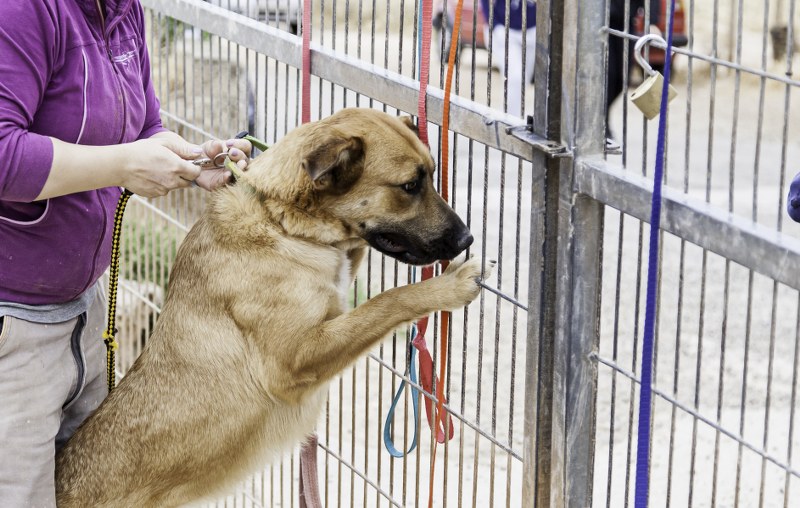 Too often, owners choose dogs that are unsuitable for their lifestyle, which can have tragic results. Too often, owners choose dogs that are unsuitable for their lifestyle, which can have tragic results.
|
The story we hear time and time again is about owners giving up their dog to a shelter or rescue because their lifestyle prevented them from keeping the dog they chose. Perhaps they selected the wrong breed for their household, perhaps their desire for a pet was out of sync with their ability to properly care for a dog, or perhaps they listened to the dog’s sad story and need for a home rather than considering the family’s needs and capabilities. Regardless, the end result is an all-too-familiar story: they never established a bond with the dog and became frustrated enough to send it away.
So, we present this Guide to help prospective dog owners navigate this brave new world of dog acquisition and ownership, and to make more informed pet choices that will build a lifetime of happy memories.
Our inspiration: NAIA was founded in large part out of frustration over the weak and often misleading information about animals available to the public. This lack is especially noticeable in the realm of pet dog selection, where agenda-driven recommendations are common and useful information is rare.
Dogs are part of American life today, with more than 78 million in homes according to the 2014 American Pet Product Association (APPA) survey of pet marketplace trends. While there are more owned cats than dogs, the nature of the connection between humans and dogs gives canines a broader impact on human lives. Still, there are problems when people have access only to outdated, biased, or faulty information that can misdirect the selection process. Our goal is to upgrade the quality of information about dogs that is available to consumers, journalists, academics and others who have an interest in truly understanding the dog marketplace today. We are dedicated to that end and pledge our best in that pursuit. So with that in mind please use this program to help you in your search.
You can read straight through or skip to the links that best represents your interest:
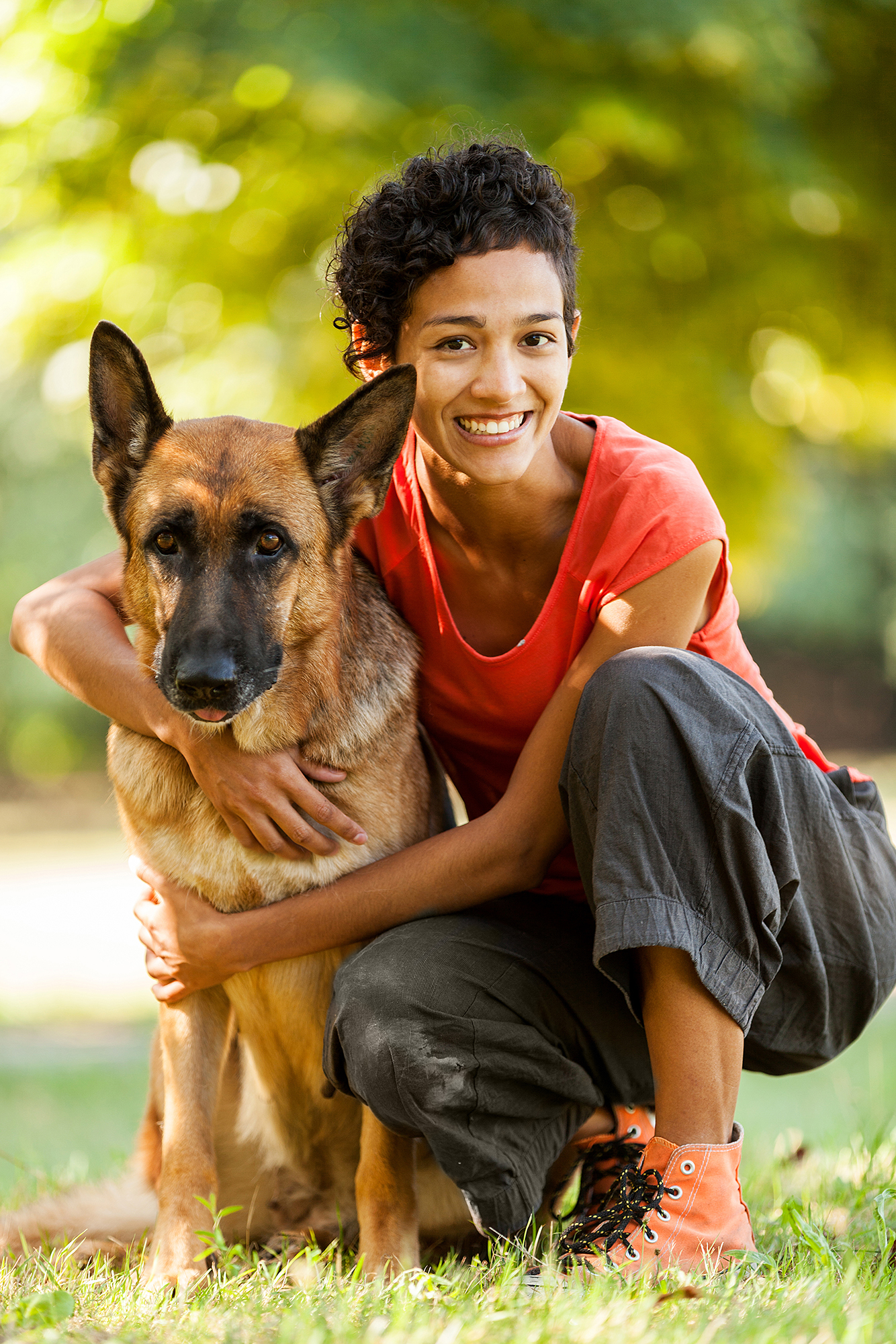 If you are ready for the responsibility, a dog can be a wonderful addition to your family. If you are ready for the responsibility, a dog can be a wonderful addition to your family.
|
Are you ready to bring a dog into your life?
A dog can be a wonderful addition to your family if you are prepared for the financial responsibilities and inconveniences inherent in caring for another living being. So put the rose-colored glasses aside and honestly answer the following questions before beginning the search for the perfect dog.
Why do you think you want a dog? The benefits are obvious; dogs are loyal, affectionate, and fun. They can be lifelong companions, guardians, or working partners, or all of the above, and they can open the door to a variety of activities, including hiking, camping, and participation in canine sports that can bring joy for a lifetime. But it’s a two-way street; dogs need veterinary care, a nutritious diet, and time for training, socialization, exercise, and love and attention for 10-15 years.
Is this the right time to bring a dog into your home? A dog can fill a hole in your life if the kids are gone or you’ve retired from your job, but you will need to think again if you want to use your newfound leisure time for frequent travel. And a dog can complicate life if there’s a baby on the way, the kids aren’t old enough to assume some responsibility for the pet, you’re facing a move, have a health problem, or your job is full-time-plus.
Can you provide a safe, comfortable, appropriate home for a dog? A dog needs good food, potable water, shelter from rain, snow, and excessive temperatures, and most of all regular quality contact with humans, but these are only minimum requirements and do not include training and socialization from day one that builds the faithful, attentive, and happy relationship that attracts people to dog ownership.
Do all household members want a dog? If not, it may not be the right time to get a dog. If an agreement can be reached, you should be prepared to manage the dog so family members or roommates are not unduly inconvenienced.
Summarizing, no matter how appealing the idea of acquiring a dog might be, buying or adopting a dog requires careful thought and introspection. NAIA offers these additional resources to help you make this important decision.
Dog Owners Guide
Dog Infomat
Dog Breed Info Center
Dog Play: Finding the Right Dog
Breed or Mix: Once you have determined that you are ready for a dog, your next step is to decide on the kind of dog that is right for your lifestyle. What do you plan to do with your dog? Are you looking for a family dog? If so, is your family active? Are there kids? Do they hike, camp, like to romp around the yard and house? Are you a health nut looking for a jogging partner or someone who just enjoys a leisurely stroll with your dog? Are you looking for a comfort dog, one that will laze around the house and hearth or lie comfortably at your feet, sounding an occasional alarm when a stranger approaches the house? Do you want a purebred, a mix, or a mongrel? Do you want a puppy or an adult dog? Is grooming something you enjoy and have time to do? Do you want a dog like the one you grew up with?
Purebred dogs: People developed dog breeds as working partners and companions with particular sets of traits suited for particular climates and tasks. Although few of these original jobs remain, modern dogs retain the physical and mental characteristics of their predecessors. Each breed’s DNA programs the dog’s size, coat type, energy level, trainability, grooming needs, athletic ability, attitude, and talent, so you can be pretty sure that surprises will be limited. For example, the Labrador Retriever – America’s most popular breed – is a 60-70-pound hunting breed with a talent for retrieving ducks and a short double coat that insulates against cold river water. As a family pet, the Lab loves people, has a penchant for carrying objects in its mouth, requires grooming when shedding that short double coat, and needs exercise to keep in shape and out of trouble. Labs easily master the good manners necessary for family life but can be rowdy if untrained. While an active family with older children may find these traits acceptable, the Lab may not be a good choice for a family without the time and energy for regular exercise.
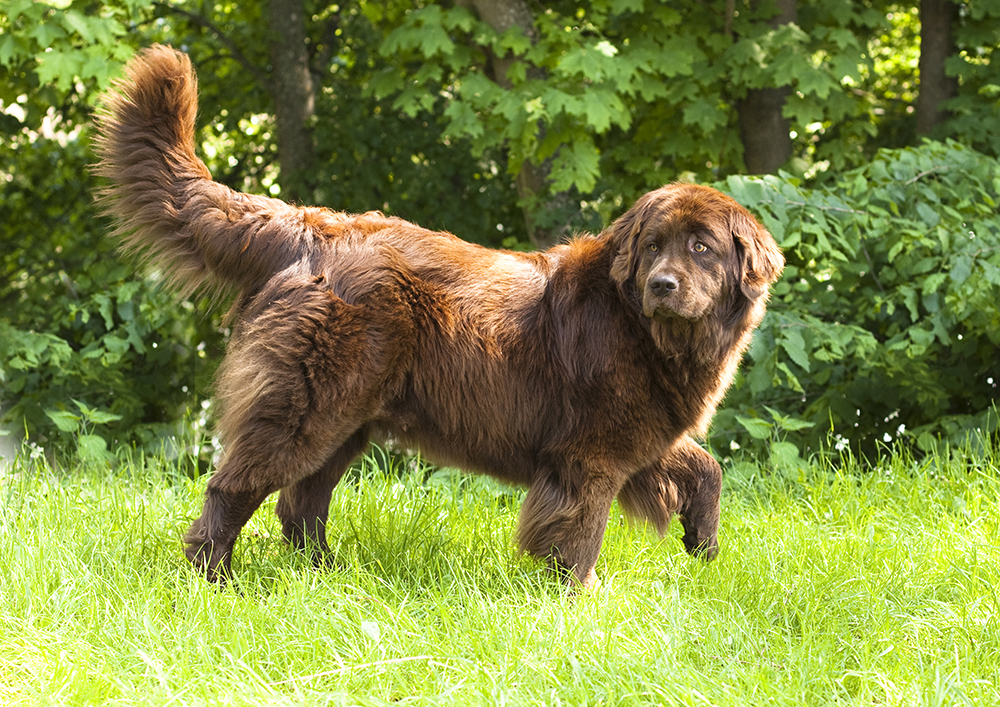 Newfoundlands are bred specifically for their size, strength, and calm demeanors. They are legendary for rescuing people from the water! Newfoundlands are bred specifically for their size, strength, and calm demeanors. They are legendary for rescuing people from the water!
|
Mixed breed dogs: The offspring of two purebred dogs, mixed breed dogs also carry traits from both parents, but the influence of those traits is unpredictable. For example, a cross between a short-coated breed of hunting heritage – the Labrador Retriever ̶̶ and a long-coated working breed such as a Siberian Husky or Alaskan Malamute could produce puppies with the size, grooming needs, friendliness, trainability, and exercise needs of the Lab or the size, grooming needs and harder-to-train independence of the working breed – or each pup in the litter may fall somewhere in between in some traits and not show others at all. Some mixed breed dogs are purpose-bred, sometimes in an attempt to develop a new breed or sometimes simply as a marketing tool. See A quick word about doodles and designer dogs below.
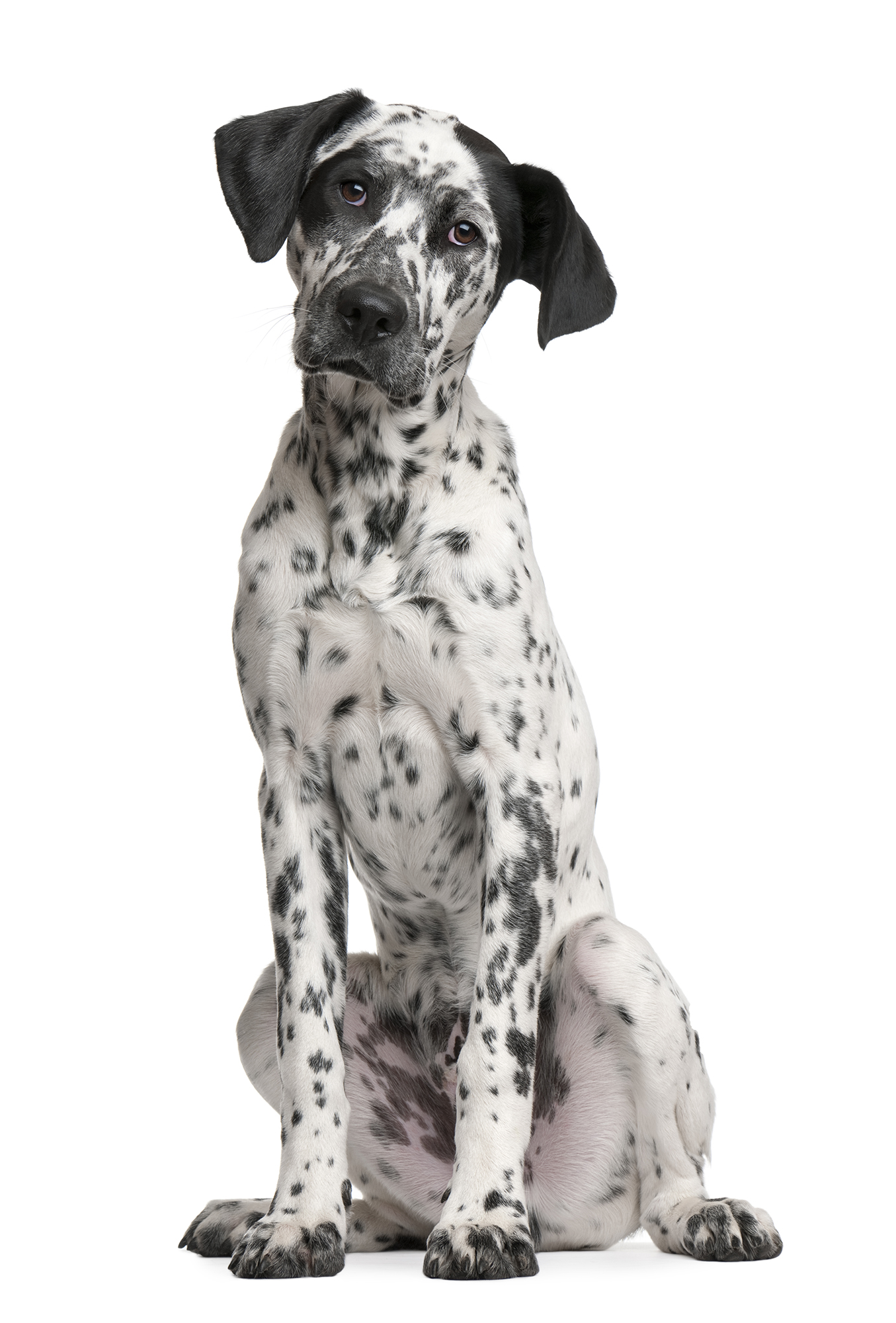 Without knowing her parents, we can only guess about her heritage... but we DO know that she is awfully cute. Without knowing her parents, we can only guess about her heritage... but we DO know that she is awfully cute.
|
Mixed breeds can be wonderful pets and can compete in some dog sports if you are so inclined, but their traits are not predictable and despite some marketing claims, they can suffer from the same inherited disorders as purebreds and mongrels. See Pure breeds, mixes, and designer breeds in the NAIA Library for more information.
Mongrels: Mongrels are random-bred dogs of mixed heritage. They may have a purebred or mixed-breed parent, two mixed-breed parents, or mongrel parents. They may be strays or street dogs rescued from a life on the run and placed in shelters to find a new home or the result of accidental litters produced by family pets. As with mixed breeds, mongrels are subject to most of the same diseases that plague other dogs, including cancers, eye disease, epilepsy, hip dysplasia, hypothyroidism, heart disease, autoimmune diseases, and allergies.
Mongrels can make great pets and can compete in some dog sports, though their traits are even less predictable than mixed breeds.
Breed-specific advantages: Traits such as size at maturity, life span, energy level, exercise needs, guarding, herding or hunting behaviors, and propensity to shed are important for many prospective dog owners, and these traits are predictable with a fair degree of accuracy in purebred dogs. It is also easier to identify potential health issues when dealing with a specific breed of dog and to minimize the potential for some diseases and abnormalities by buying a puppy from a breeder who carefully screens parent dogs.
Breed history: Purebred dogs have a history and background that contribute to their physical and mental characteristics. For example, farmers and merchants in the British Isles developed terrier breeds to hunt and kill vermin from mice and rats in kitchens, barns, and granaries to foxes that raided hen houses. As a result, terriers are feisty, fearless and completely dedicated to their work. Most terriers have harsh coats to protect them from cold damp weather and their inborn purpose can yield a strong propensity for bossiness.
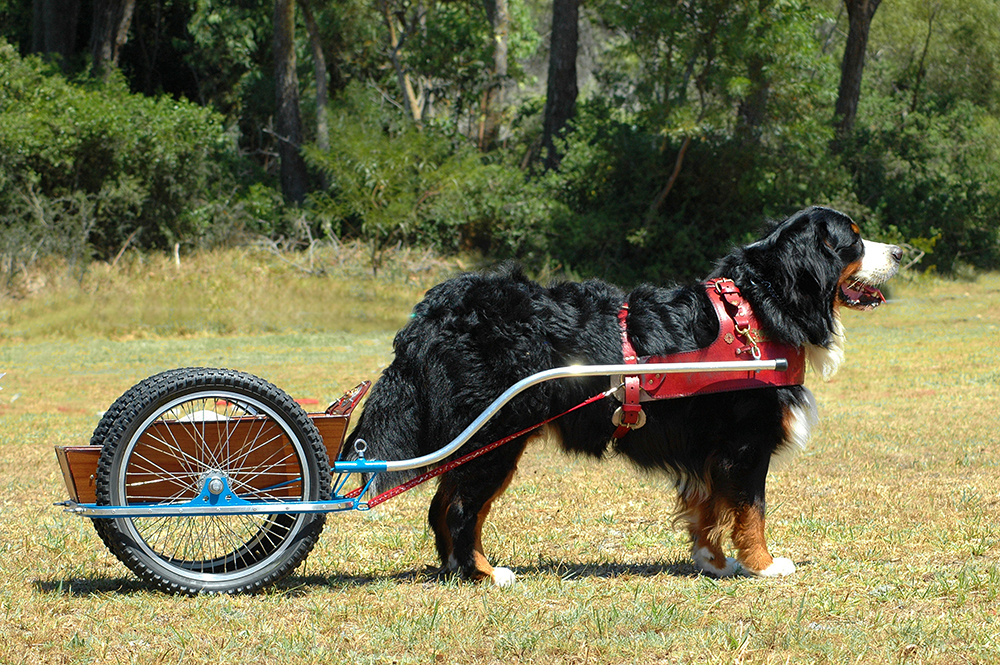 Bernese Mountain Dogs pulled carts in Switzerland a century ago. Today they are more likely to give children a ride or engage in competitive carting. Bernese Mountain Dogs pulled carts in Switzerland a century ago. Today they are more likely to give children a ride or engage in competitive carting.
|
Physical activities: Some breeds love nothing more than to spend their days sleeping on the couch and require minimal physical activity to remain happy and others don’t feel complete until they’ve retrieved waterfowl from ponds or dense underbrush in brisk fall weather; tracked game through the woods, or helped move a flock of sheep from one field to another. These active dogs are unlikely to find these traditional pursuits in modern pet households, but they must have exercise commensurate with their needs. Some owners participate in dog sports like field and herding trials or lure coursing or barn hunts that simulate the jobs their dogs were designed to do; others participate in more generic dog sports such as agility or obedience, as these are designed for all dogs; and still others walk or hike with their pets. For more information about dog sports that dogs and dog owners enjoy, see the American Kennel Club website here and here and the United Kennel Club website
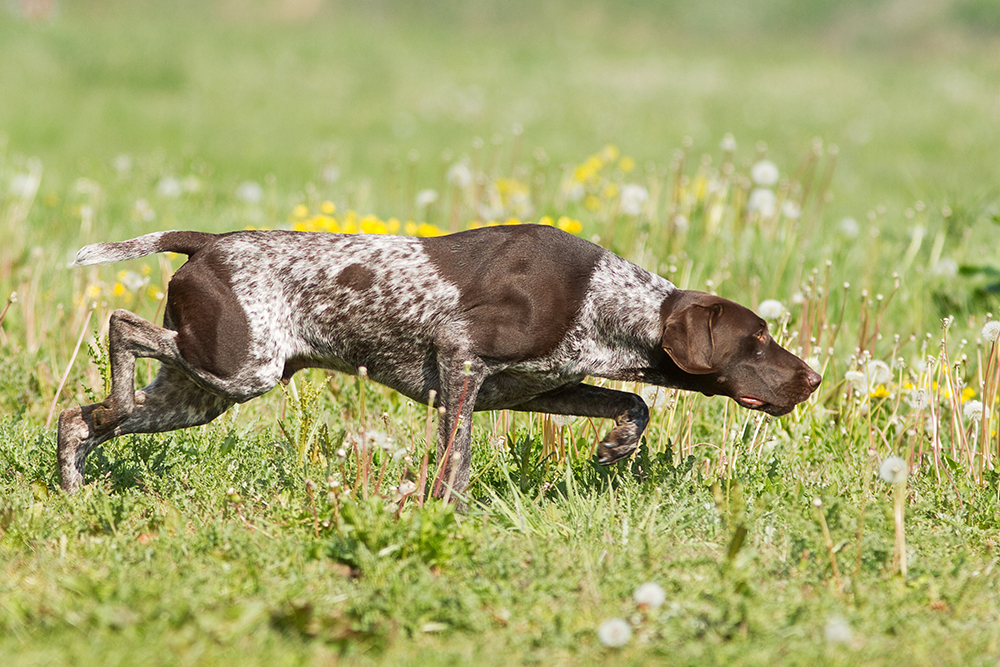 German Shorthaired Pointers have a strong hunting instinct, and need an owner who can provide them with plenty of off-leash activities! German Shorthaired Pointers have a strong hunting instinct, and need an owner who can provide them with plenty of off-leash activities!
|
Behavior: Dog breeds can vary in behavioral tendencies, too. Some breeds – even large, imposing ones – are incredibly patient and gentle with children while others are more likely to bond with one family group or one owner. Some are “talkers” (this means they bark or howl a lot), some possess powerful prey drive, and some are fiercely protective of their family or territory. Breeds developed to herd livestock (collies, shepherds, sheepdogs, etc.) may also try to herd children or other pets and those with a hunting background (spaniels, retrievers, setters, etc.) often seek out and carry objects in their mouths.
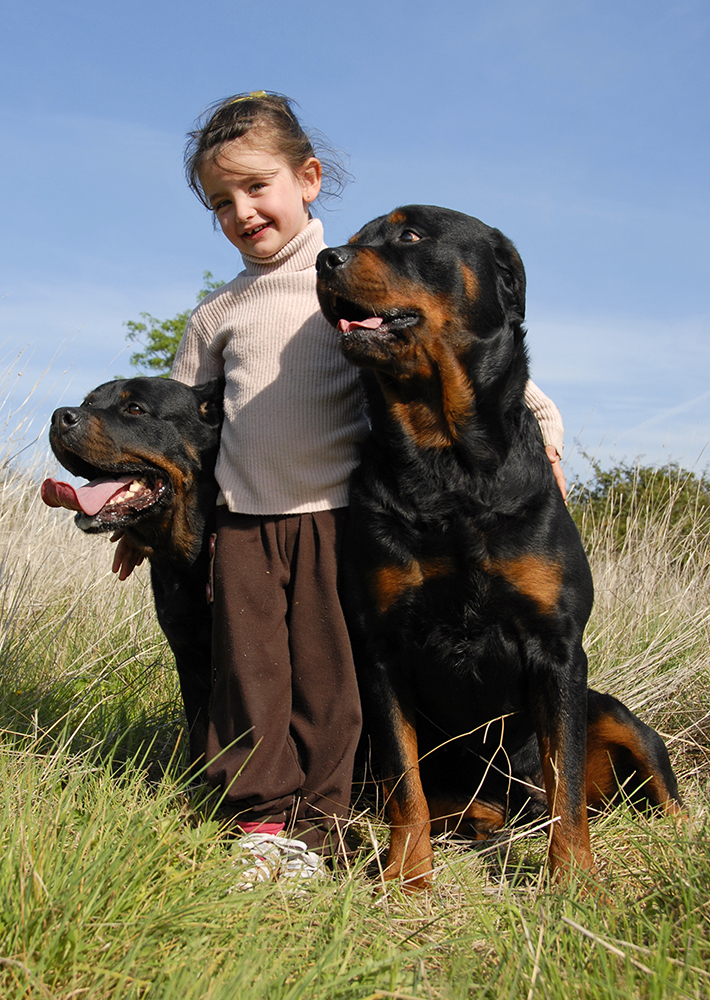 Socializing and supervising your dogs with children can create a powerful bond and great lifelong memories. Socializing and supervising your dogs with children can create a powerful bond and great lifelong memories.
|
Special dietary considerations: This can be a contentious issue even among long-time breeders, but the bottom line is that some breeds have a higher potential for food allergies than others, while some need more or less protein – and from different sources – than others. If you get your purebred from an experienced breeder their recommendations on the proper diet can be very important.
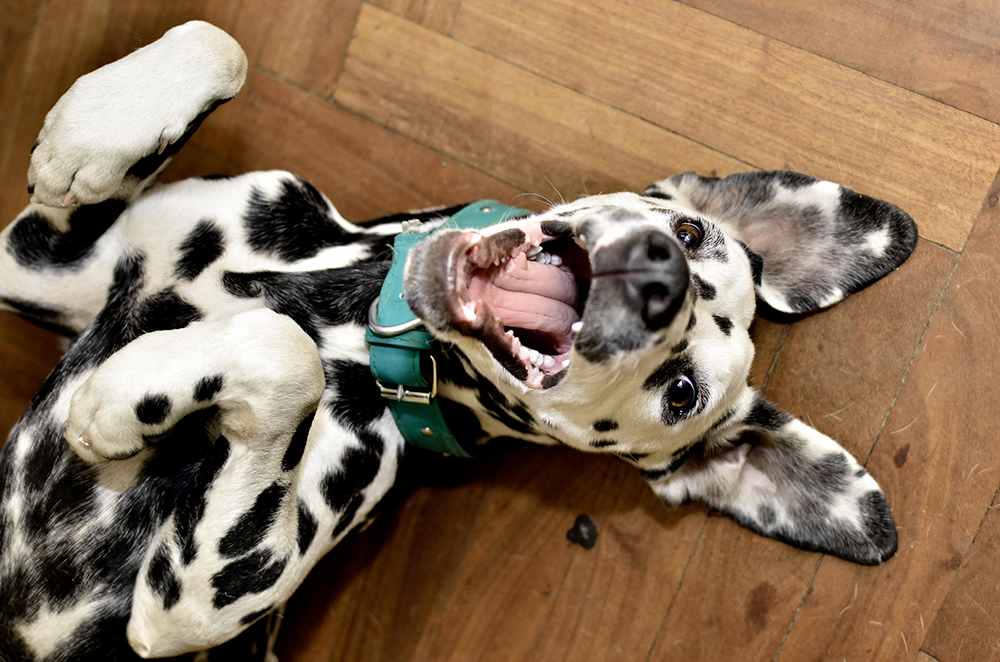 Your Dalmatian will be happiest on a diet without red meat and a slightly lower percentage of protein compared to similarly sized and active breeds. Your Dalmatian will be happiest on a diet without red meat and a slightly lower percentage of protein compared to similarly sized and active breeds.
|
Health concerns: Information and opinions about dog health are everywhere and often spark long-running debates that confuse and worry new puppy buyers. The bottom line is that even the most carefully selected puppy – mongrel to purebred and everything in between - can develop a health problem, but the likelihood diminishes greatly if the puppy comes from a breeder who uses genetic testing and carefully monitors breeding stock.
Buyers should know that screening tests exist for hip dysplasia, some eye diseases, heart abnormalities, knee problems, thyroid disease, dental issues and more; that some of these diseases or conditions affect many breeds and others afflict only a few breeds. They should also realize that these health hazards exist within mixed breeds and mongrels too. Conscientious breeders test their breeding stock for the diseases that have more than a random incidence in their breed if a health test exists; and for conditions that currently have no screening test, the breeder monitors their dog's health before breeding.
Special breed considerations: Some breeds of dog require regular grooming (Poodles and Yorkshire Terriers, for example) that could end up costing an arm and a leg, while others (Samoyeds, Collies, Alaskan Malamutes among the many) require less grooming, but shed hair by the pound once or twice a year. Short-coated breeds may need extra padding (like a sweater) to keep warm in cool climates or cold seasons, whereas those with thick or long coats may start panting when the thermostat goes above 70 degrees.
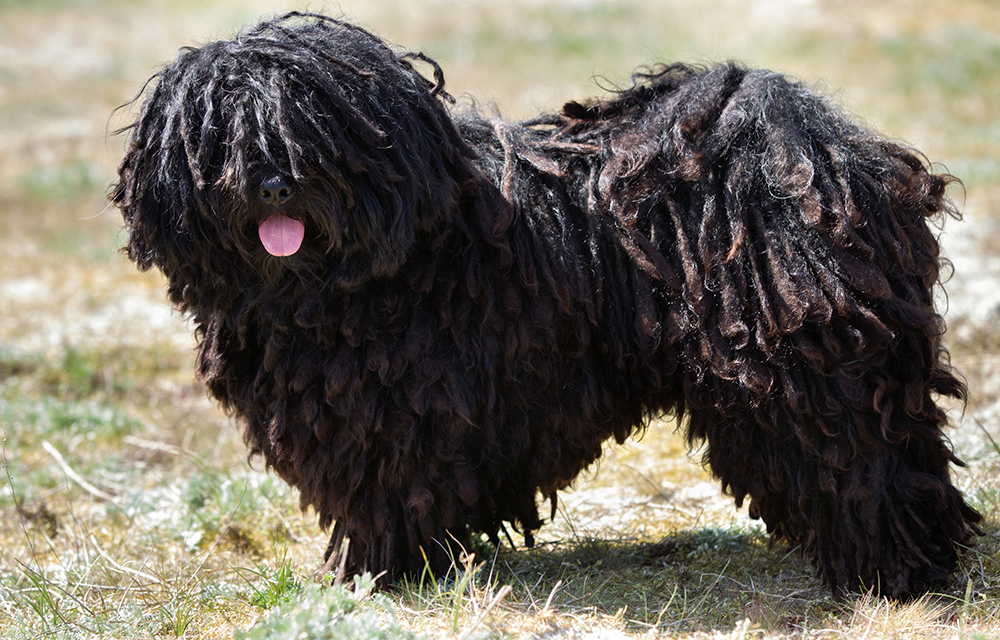 According to the Puli Club of America, bathing your Puli is no more difficult than bathing any other breed of dog. However, drying is a laborious chore and one that must be done, lest your poor dog gets mildew in their coat! According to the Puli Club of America, bathing your Puli is no more difficult than bathing any other breed of dog. However, drying is a laborious chore and one that must be done, lest your poor dog gets mildew in their coat!
|
The energy level can also be a consideration when selecting a breed. For example, some terriers, herding and sporting breeds can become destructive or neurotic if they don’t get enough physical exercise and brain stimulation.
Breeds developed as watchdogs and specialized hunting breeds can be noisy and require management to avoid neighbor complaints. For example, hound breeds may howl when happy or lonely, Norwegian Elkhounds and Finnish Spitz may bark with joy at locating whatever quarry they seek, and Canaan Dogs may alert owners to anything from a potential intruder to a butterfly.
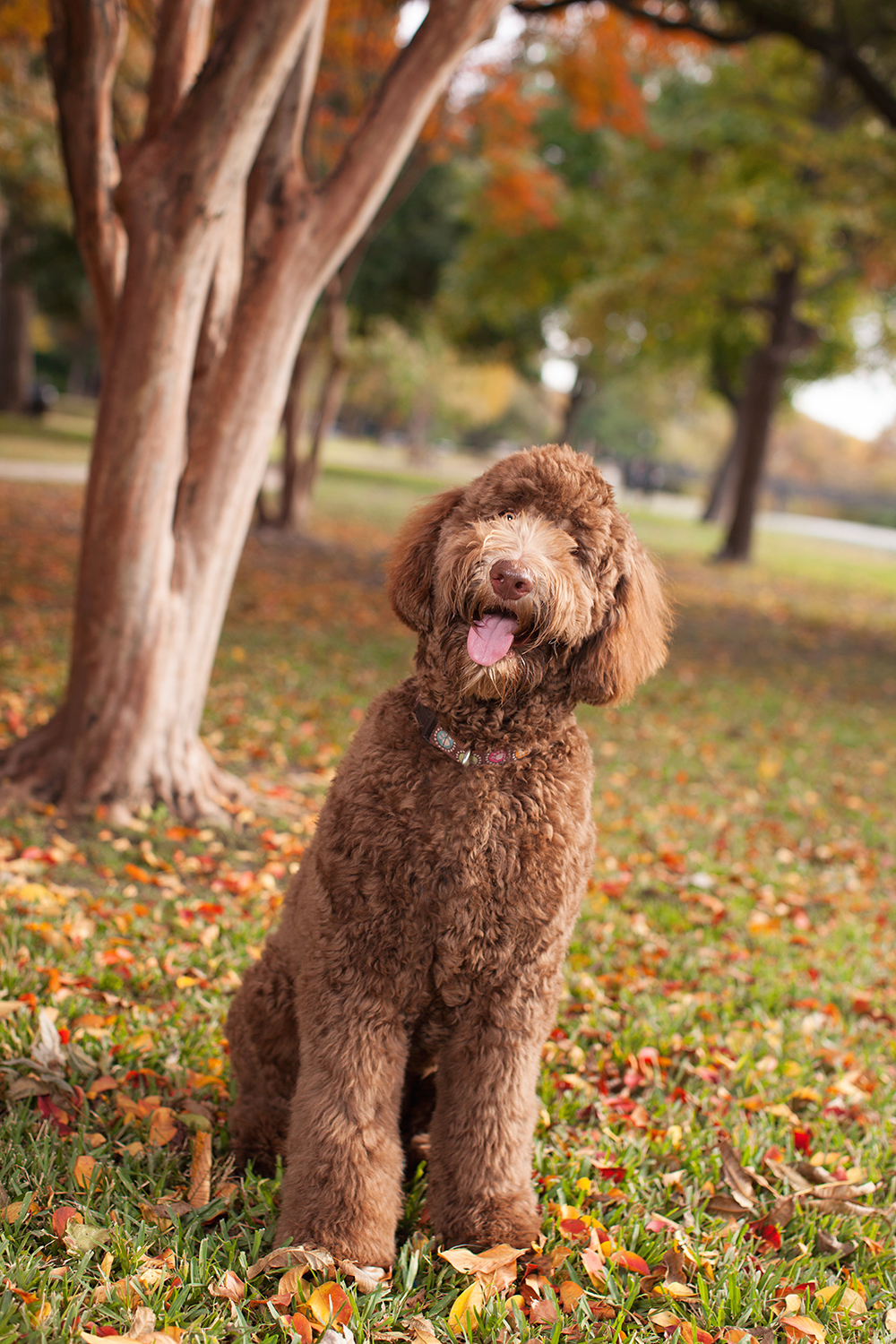 While many of the Labradoodle's "claims to fame" are unproven or false, they are a popular and beloved choice for many dog owners. While many of the Labradoodle's "claims to fame" are unproven or false, they are a popular and beloved choice for many dog owners.
|
A quick word about doodles and designer dogs: Over the last decade, the popularity of “-doodles” and other designer dogs has exploded, creating a large market for both commercial and casual breeders. These are mixed-breed dogs, usually a Poodle paired with a Labrador Retriever or other breed, often accompanied by claims that the dogs are hypoallergenic, don’t shed, and are more robust due to “hybrid vigor.”
It is important to know that at this time, there is no conclusive proof for any of these claims, and some are known to be false. The reason for this lack of certainty is pretty obvious to even the most basic genetics investigator: none of the offspring has the genetic predictability of either purebred parent. (It takes generations of pure strain breeding to produce predictable instinctive traits, structure, coat type, and other physical and mental characteristics. For example, if you cross a Bloodhound with a Greyhound, the offspring may not possess either fleetness nor scenting superiority.
This is not to say that designer dog breeders are automatically a poor source for your next dog. As in any field, there is a bell-curve, with unacceptable settings on one end, and conscientious, quality breeders on the other. There are many wonderful, healthy doodles available if you remember not to take all the claims at face value and are ready to accept a higher level of unpredictability in the puppy you take home than if you’d picked either of the purebred parents.
It’s important to remember that people created today’s purebred dogs to fill particular needs, work in specific climates and terrains, and perform specific functions. Some breeders of designer dogs are working toward the same goal with the most notable attempts involving the Labradoodle (Labrador Retriever/Poodle crosses) and the Cockerpoo (or Cockapoo — Cocker Spaniel-Poodle crosses). The Cockerpoo Club has disbanded; for more information on the Labradoodle, see http://www.australianlabradoodleclub.us/. And for more information on several popular crossbreds and the process of turning a crossbred into a purebred, see “Hot Dogs: Fourteen of the Top Designer Dogs” from Barron’s Educational Series
What about getting an older dog? It’s hard to find somebody who doesn’t get excited at the prospect of bringing a puppy into the family, but adult dogs can make wonderful pets too, and they come with several advantages that prospective owners may overlook. For example, while all dogs need regular exercise, fully grown dogs typically have less energy than puppies, making them more suitable for a low-activity household. And since the dog is already full-grown, you can see the size, coat type, and other important physical traits even if you have no idea of the dog’s breed. A healthy older dog needs fewer routine veterinary visits for vaccinations or worming and may be spayed or neutered already.
Sources of older dogs: Breeders and performance dog trainers sometimes have retired show or working dogs they want to place as pets so the dogs get the love and care of a family. Responsible breeders also may search for a new home for an older puppy or adult dog that an original buyer returned.
Other sources include breed rescue groups; all-breed, mixed breed, and mongrel rescue groups; private shelters; public shelters i.e., dog pounds; and individual owners who can no longer keep their pets. These sources have different modes of operation. Breed rescue groups affiliated with a national or regional breed club typically have codes of ethics and take time to evaluate each dog before placement in a new home. Many shelters and other rescues also take steps to match the dog with the family, but a growing number of these organizations are agenda-driven and more interested in getting dogs out the door than in preparing the dog for adoption and making good matches. News articles report stories of dogs imported from foreign countries. This is a concern for both animal and public health.
Furthermore, there can be some unanswerable mysteries about an older dog, so asking the right questions is important. Be sure to find out if the person or organization with possession of the dog has the following information on a prospective pet:
The dog’s breed(s) and place of origin: Knowledge is power; if you know where your dog comes from, you’ll have some clues about its activity level, behavior, previous lifestyle, and potential health issues. These details can help you and your new adult dog create a happy and healthy life together.
The dog’s age: Knowing your dog’s approximate age is important for his well-being, medical needs, and appropriate physical activities. For example, although dogs of some breeds such as the Golden Retriever and Border Collie may have a lot of energy until they are nine or 10 years of age, they need a general health checkups and conditioning for jogging, long-distance hiking, or strenuous sport unless they are already accustomed to vigorous exercise. Dogs past seven or eight years of age are also more susceptible to arthritis and some other diseases as a normal part of the aging process.
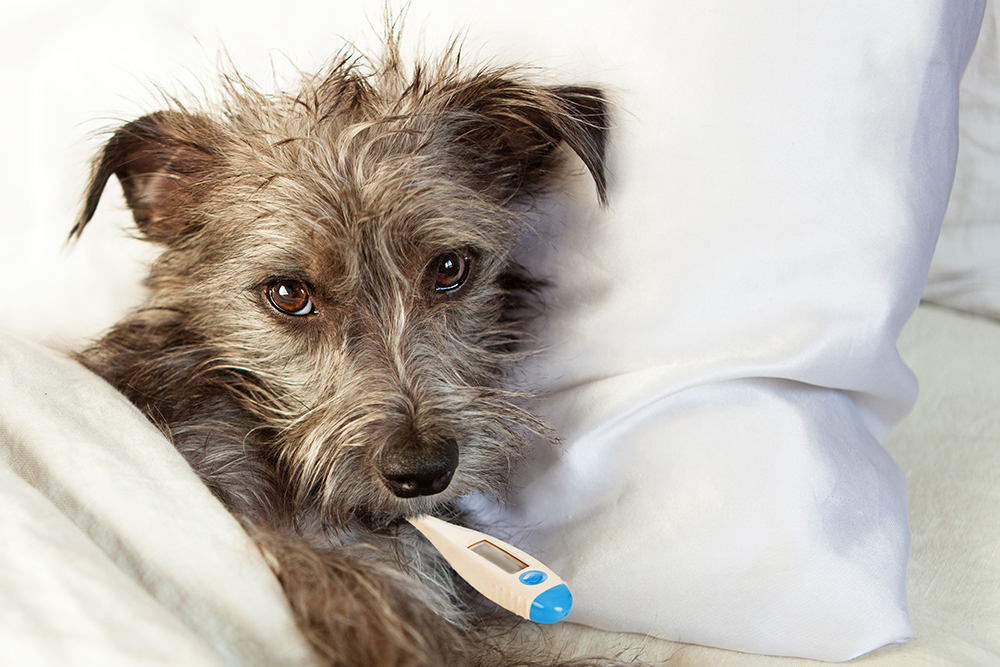 A new dog should get a trip to the veterinarian for an assessment of general health within a few days of acquisition. A new dog should get a trip to the veterinarian for an assessment of general health within a few days of acquisition.
|
The dog’s medical history: If the dog has obvious physical problems, i.e., an injury, a limp, a rash, a tumor, a runny nose or cough, ask if he has been seen by a veterinarian and if he is under treatment for that or any other problem. Get a copy of the vet’s diagnosis and treatment protocol if possible. If health information is not available or there’s an untreated malady, the new dog should get a trip to the veterinarian to assess its general health within a few days of acquisition.
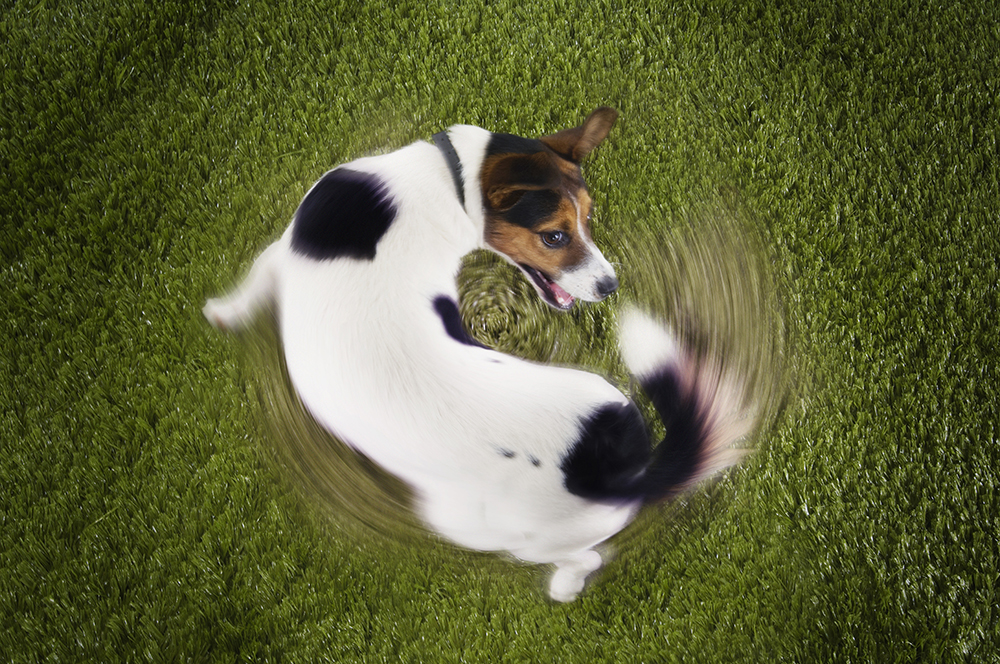 Most rescues and many shelters learn the quirks of the dogs they house and do their best to learn each dog’s history, to better place them in a safe and appropriate home. Most rescues and many shelters learn the quirks of the dogs they house and do their best to learn each dog’s history, to better place them in a safe and appropriate home.
|
The dog’s behavioral quirks and history: Many older dogs are wonderful – and may be fully trained! – but some may come from homes where they were neglected and never learned basic manners or were relinquished because they indulged in destructive or aggressive behavior. Most rescues and many shelters pay close attention to the behavioral quirks of the dogs they house and do their best to learn each dog’s history (though this is not always possible) to help ensure placement in a safe and appropriate home.
A personal note on dog selection: Prospective dog owners would do well to take their own emotional needs into consideration when selecting a breed. After all, despite their unique qualities, many breeds also have similar traits that can fit a particular lifestyle or family. For example, most sporting breeds are friendly and outgoing, most terriers are feisty, many herding and guardian breeds are aloof or suspicious of strangers, etc. These grouped similarities do not make the breeds interchangeable, however; a prospective buyer should also feel an emotional connection with the specific look, attitude, history, or character of the chosen breed.
Where to find your faithful Fido: It was little more than a century ago when most Americans lived on farms and valued dogs primarily for their working and hunting abilities. During and following the Second World War, the trek from farm to urban neighborhoods accelerated, and so did dog ownership. In the city, the working and hunting instincts of dogs were not sought after to the same extent as in country life but the popularity of purebreds - and purebred pets in particular – mushroomed, and they were no longer just for the rich. In the early 1950s dog ownership expanded exponentially as more Americans purchased homes and were able to add a dog to their family. The pet industry came along and changed the way that dogs were distributed and sold. The Internet and transportation advances continue to change the manner in which dogs can be obtained by the public.
In earlier days, there were limited sources of purebred dogs — and few pure breeds — in the US. Today we have more breeds to choose from (Appenzeller Sennenhunde, anyone? How about a Coton de Tulear or Nova Scotia Duck Tolling Retriever?) and more sources to consider. Each breed has specific individual characteristics so careful thought is essential.
If you are looking for a purebred, there are several types of breeders and sources:
Regardless of the source, buyers should only accept a dog or puppy from someone (breeder, pet store, rescue or shelter) who operates in a transparent, businesslike way and who gives the new dog or puppy owner the information necessary to make an educated decision.
Prospective buyers should take care that …
Animal shelters, both private and public, are among the primary sources of dogs available to American consumers. A 2016 NAIA dog ownership survey suggests that approximately 20% of dog owners acquired their most recent dog at an animal shelter.
Animal shelters fall into two major categories, depending on their governance and their methods of operation, which often have some degree of overlap. They are:
1) Private animal shelters
a) Limited admission animal shelters
b) Retail shelters
2) Public (government) shelters
a) Open admission animal shelters
1) Private Animal Shelters: A traditional humane society or Society for the Prevention of Cruelty to Animals (SPCA) is an organization that operates one or more brick-and-mortar animal shelters, whose primary role is to shelter and place homeless animals from their community and raise awareness about animal welfare and abuse issues. Private animal shelters are not-for-profit organizations that operate from a mission under the direction of a board of directors. Because most private shelters operate as charities under the IRS code 501 (c) 3, donations made to them can typically be deducted.
Humane societies developed in the mid to late 1800s in response to a rapidly urbanizing society where the plight of stray and abused animals could readily be observed. Despite the need for these organizations, they were often unappreciated, even resented and seldom had appropriate funding to do the work at hand. But they were staffed by dedicated people who often worked without recognition or reward because of their deep desire to help animals in need and end animal suffering.
Stray dogs roamed the streets of many large US cities toward the end of the 19th century creating public health and safety issues. Rabies was a seasonal problem in some areas so when a rabies vaccine was developed, public health agencies and municipal governments increased their programs to protect the public, sometimes working jointly with private animal shelters that housed the strays after roundups, and sometimes instituting their own animal control agencies and pounds.
In the early decades and continuing to this day in some areas, pounds took on the role of protecting the public from free-roaming and potentially dangerous dogs, while humane societies focused more on sheltering. There is considerable overlap in their roles today, with some humane societies maintaining limited police power acquired a century or more ago before municipal governments created animal control agencies. By the same token many city animal control agencies today offer housing and rehabilitation of dogs and cats equal to the best humane society.
Private shelters may have the words “humane society” or “society for the prevention of cruelty to animals” (SPCA) or “humane association” in their names, but they are not affiliated with the three large national associations; the Humane Society of the US, (HSUS), the American Society for the Prevention of Cruelty to Animals (ASPCA), or the American Humane Association (AHA).
There is no question about the important role private animal shelters have played in American society over the last century and a half while pet owners were learning how to live with animals in densely populated urban areas. Spaying and neutering weren’t widely available until the fifties and Americans weren’t yet focused on preventing pet pregnancies. Instead many families routinely brought unplanned litters to local humane societies for placement or euthanasia.
Because of their heroic work in sheltering homeless dogs during the decades when America was in the throes of a serious dog overpopulation problem, private shelters were often exempted from the cruelty and public disclosure laws that are applied to other animal businesses. Now that dog overpopulation is solved in many parts of the US and shelters and rescues have become a major source of dogs in the pet marketplace (with many shelters importing dogs from outside of their local service area), the lack of shelter oversight presents new concerns.
With the end of dog surpluses in many parts of the US and the resultant changes in the dog marketplace, several states have adopted laws requiring animal shelters to disclose the number, source, and outcome of the dogs they receive. Colorado has the most robust shelter and rescue data. They require shelters and rescues (as well as other animal businesses) to be licensed and file annual reports disclosing 1) the number of dogs they take in each year; 2) where they come from (local sources or out of the area and/or out-of-state sources); 3) the age of the animals taken in and; 4) the disposition of shelter dogs: a) returned to owner; b) adopted out; c) euthanized or; d) transferred to a foster home, a shelter or rescue.
This information is vitally important for tracking infectious diseases such as distemper and parvo and zoonotic diseases such as rabies. This information also provides policymakers with a better understanding of the pet marketplace – without which, it is very easy for lawmakers to enact poorly designed, ineffective and/or misguided laws and policies.
Note: Until the beginning of the 21st century, the only significant interstate commerce in dogs was generated by the commercial pet industry. Today, many rescues and shelters move vast numbers of dogs from areas of high supply to areas where there are not enough dogs to meet demand as part of their standard operating procedures.
a) Limited Admission Animal Shelter: The term “limited-admission shelter” applies to a shelter that limits the types of pets it accepts. Traditionally, humane societies and SPCA’s viewed their role as sheltering animals in need, rehabilitating them to the extent allowed by their funding, and then finding homes for them. Importantly, the public continues to perceive this as their primary role as well. But as the number of surplus dogs declined some shelters changed their priorities from sheltering dogs in need to becoming a source of pets in their community. Some of these shelters have evolved into de facto pet stores, stocking their shelters with an unregulated source of animals.
Shelters have always had space and funding limitations which forced them to turn some animals away, but many limited-admission shelters today accept only those animals that can be adopted out easily, sending all others to other rescue entities or government shelters. Limited-admission shelters often market themselves as no-kill shelters, but in many cases that term only signifies that the shelter no longer fulfills its historic role. The alternative to a limited-admission shelter is an open-door animal shelter.
b) Retail Shelters: A retail shelter is an animal business that maintains a public image as a traditional humane society or SPCA but operates more like a pet store than a traditional shelter. Such shelters often travel long distances out of their service areas to acquire pets to sell rather than serve the needs of local animals. Some retail shelters import dogs from foreign countries to keep their shelters well stocked. Along with a large number of dogs (and an increasing number of cats), retail shelters often sell a full range of pet supplies to their customers such as leashes, toys, pet food, and health care products. Retail shelters call their sales adoptions and market themselves as animal protection organizations, assertions that give them a marketplace advantage over other pet sellers. They advertise their imported dogs as rescued from certain death in kill shelters in the southern US or from the streets of foreign countries. Most dogs offered in the retail shelter channel come with a sad story. Shelters market these stories and offer consumers the opportunity to save lives.
There is a serious debate among shelter personnel about the practice of shelters importing dogs from out of their region, the concern being that it does not solve problems at the source, but instead creates a pipeline source of dogs for shelters that otherwise might need to close their doors. Critics view this practice, which shelters call “humane relocation” as self-serving and taking advantage of an animal welfare problem rather than solving it.
2. Public shelters and pounds run by municipal governments: Government-run animal shelters go by several names: animal services, pounds, animal care, and control and simply animal control. Depending on how much funding they receive from their municipality, their operations can vary tremendously, ranging from ones that offer full-service sheltering to operations that are little more than holding facilities. Well-funded animal control agencies serving major cities typically perform a full range of animal services, which often equal or even exceed the services provided by private shelters. At a minimum, these agencies accept strays and shelter them for an established length of time so that lost dogs have time to be reclaimed by their owners or adopted out instead of being euthanized.
Depending on the space and funds available as well as the ordinance they operate under, they may continue to hold animals for extended periods of time or euthanize them for space. Typically, animal control agencies vaccinate their pets before releasing them to the public. Many government-run shelters neuter pets before releasing them to the public or at minimum impose requirements on adopters to neuter pets within a short period of time following adoption. Some shelters send adopters to a network of local veterinarians who perform spay-neuter surgeries at a reduced cost, which the shelter subsidizes. If funding allows, many government-run shelters go much further, providing veterinary care for a variety of conditions, assessing temperaments and training and rehabilitating dogs with behavioral problems.
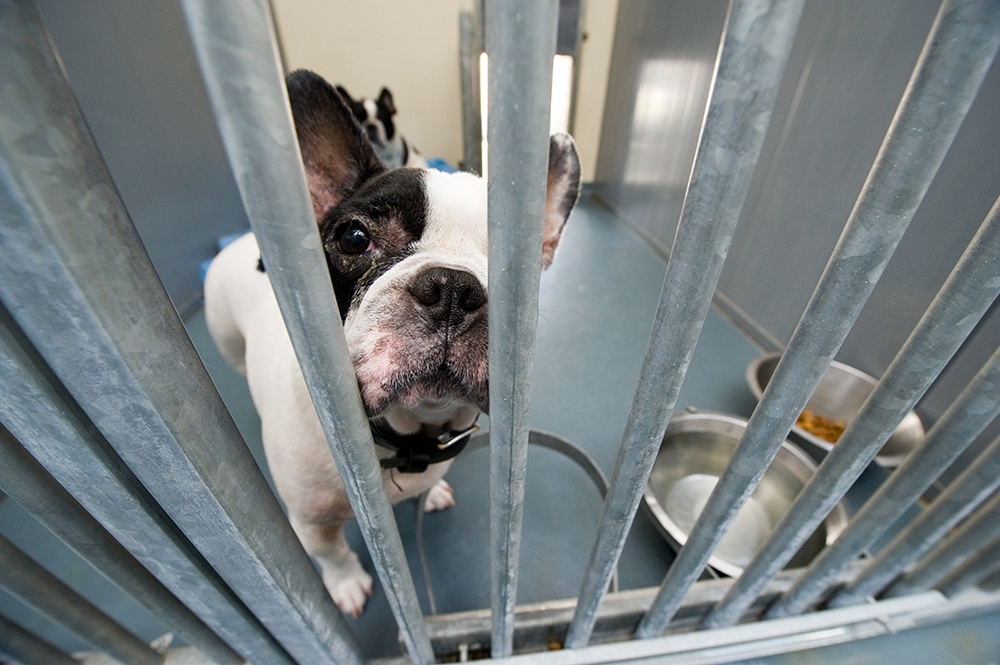 The operations of a public shelter can vary tremendously, ranging from full-service sheltering to operations that are little more than holding facilities. The operations of a public shelter can vary tremendously, ranging from full-service sheltering to operations that are little more than holding facilities.
|
Public shelters get their funding from dog license fees, tax dollars, and fines levied against dog owners who break animal control laws. They are part of local law enforcement; their tasks include the enforcement of animal welfare laws, the capture of stray dogs and the protection of public health and safety from dangerous and free-roaming dogs. If the dogs they impound are not reclaimed by owners, the shelter can dispose of them in several ways — offer them for adoption, transfer them to a foster home or private shelter where they can be put up for adoption, or euthanize them, usually after a set time period. Public shelters may gain reputations as “kill shelters” because they have limited space and money to care for dogs and because many times they are “open admission” they may receive pets with end-of-life decisions, terminal diseases or dangerous behavior conditions, resulting in higher euthanasia rates.
Open Admission Animal Shelter: An open-admission animal shelter, which is sometimes referred to as an open-door shelter, is an animal shelter that will accept any dog, even if only temporarily, regardless of the animal’s behavior or health status. Most municipal shelters are open-door shelters. Because of their willingness to accept dogs that may not be adoptable, this type of shelter rarely labels itself as a no-kill shelter. By the same token, some rescuers and private shelters may send their most difficult dogs to an open-admission shelter and then label it disparagingly as “the kill shelter.” Open admission shelters also have a larger number of euthanasias due to owner requested end of life decisions and the relatively low cost or free service they offer compared to a veterinarian clinic.
Traditional rescue groups take in, house and find permanent homes for pets in need. Unlike shelters, they are rarely brick and mortar buildings but generally operate out of private homes or networks of private homes. They can be run by a single person, by organizations and/or by networks of rescuers working together. Some are part of national breed club rescue networks, such as the Doberman Pinscher Club of America Rescue, while others may focus on local shelter dogs. They can be well-organized groups with nonprofit tax status and established codes of conduct. They can also be fly-by-night operations that mistreat the pets they keep and mislead adopters about the background, health, and temperament of the pets they offer. They are the least regulated source of dogs available to consumers.
Characteristics of rescue groups: Most rescues operate as charities under the Internal Revenue Service code that allows donors to deduct cash and merchandise gifts from tax returns. These groups are known as 501(c) 3 rescues after the IRS code section for charities. A 501(c) 3 group can be national, regional, state, or local. It can have a small or large budget; a facility, a network of foster homes, or both; paid staff, volunteer staff, or both; and it can solicit memberships or not. It may also sell merchandise related to its purposes such as t-shirts and sweatshirts, pet supplies, and dog training equipment.
Most rescues hold fund-raising events to support their efforts. These range from dinner dances and art shows to bake sales and 5K walks – and anything in between that has the potential to bring in money to care for the dogs they house or foster.
Many rescues, especially breed-specific rescues, are diligent about assessing the health and behavioral issues of the dogs they accept for adoption, only selecting dogs they have the resources to rehabilitate, cure or fix before placement. As their funding allows, these groups often provide up-front veterinary care to eliminate parasites, cure infections or fix a broken bone. They may also socialize, teach basic manners, and housebreak dogs that have missed these fundamentals along the way. At the same time, they typically avoid dogs that have chronic diseases that will be costly for adopters to cope with and they carefully screen out dogs with histories of aggressive behavior. In other words, these rescues are concerned both for the lives of the dogs they place and for the adopting family. They want the experience to be successful for both.
Some rescues specialize in certain breeds or groups of dogs or in rehabilitating dogs that have been seized in cruelty or neglect cases, and some take in only mixed breeds or mongrels. A small number of people who try to do rescue on their own may become overwhelmed with dogs and unable to provide proper care.
The Alliance of Wisconsin Animal Rehoming Efforts provides information to help potential adopters find a reputable rescue organization under "resources" on their home page.
Some examples of all-breed and mixed breed rescues:
All Breed Rescue in Southern California places all breeds and mixes and has a special placement service for Whippets and other sighthounds.
Columbus Dog Connection in Ohio, offers dogs and cats for placement, has a spay/neuter project, and lobbies for laws governing the breeding and sale of dogs.
Breed clubs and rescue
Most national breed clubs have a rescue organization to help find homes for dogs of their breed. Clubs of popular breeds may have regional rescue groups operated by or in conjunction with regional breed clubs.
Breed enthusiasts and many breed club members are the backbone of purebred dog rescue. They provide foster homes, act as local shelter liaisons, behavior and assessment consultants, provide transportation to new homes, and raise money to care for the dogs that enter the rescue system. They ask shelter staff to notify them if a dog of their breed enters the shelter, and they get those dogs out of the shelter as soon as possible. Breed club contacts may be searched through the American Kennel Club or United Kennel Club web sites; the breed club listings may have contact information that could enable an inquiry as to the existence of rescue organizations near your location.
Examples of breed rescue groups:
Dalmatian: Dalmatian Club of America rescue information and contacts:
Labrador Retriever: Miami Valley Lab Rescue, is a project of breeders in the Miami Valley Labrador Retriever Club serving Ohio, Kentucky and Indiana.
West Highland White Terrier: Westie Rescue, a committee of the West Highland White Terrier Club of America
Leonberger: Leonberger Club of America Rescue
Retail Rescue: Historically rescue organizations operated without thought of profit. The original rescues (as mentioned above) were extensions of AKC breed-clubs whose members wanted to prevent their breed from falling into bad circumstances. Many of them developed codes of ethics and operating guidelines. The goal was to break even; to raise enough money to be able to rehabilitate dogs, to be able to fix a broken bone, to eradicate parasites, cure ear infections, to housebreak or socialize a dog, and so on. As the number of dogs needing rescue in certain locales decreased, a new kind of rescue model emerged. These rescues found that by abandoning some or all of their predecessors' sourcing guidelines. Some rescues began buying from dog auctions or marginal kennels, by accepting dogs with temperament problems or from distant and/or unknown sources, by doing less in the way of rehabilitation and by moving a vast number of dogs quickly - they could make a profit.
Because these rescues operate as not-for-profit organizations under the IRS division for charities, the fact that retail rescues are profit-seeking businesses is often blurred in the public's mind. It may also be unclear to the public that their IRS tax status conveys no animal welfare standards. The result is that the standards of care and business practices of retail rescues are held to far lower regulatory requirements than are businesses known to be operating for profit. These entities have avoided regulation in most states so far, but that is changing. The NAIA Shelter Project Glossary provides definitions that can be useful in understanding shelter and rescue terminology.
Some of these groups offer their imported dogs to the public within days of the dogs’ arrival, not enough time to assess behavior or health status. Some of the dogs have been vaccinated, but many arrive with little or no health information. In Connecticut, veterinarians and members of the public became so concerned about diseases brought into the state by imported rescue dogs they urged passage of an import law that requires rescuers who import dogs to register with the state and provide each dog with a veterinary checkup prior to adoption. The law went into effect on October 1, 2011.
More cautions about the changing world of adoption: There is a serious shortage of dogs available to the public in many parts of the US, so consumers should be aware that an increasing number of dogs in rescues and shelters are foreign imports or strays saved from natural disasters and may not have a medical or behavioral history. A growing number of shelters offer these imported dogs for adoption within hours or days of their arrival, and may not assess their health or behavior or put effort into matching them with the right family. Some of these imported dogs have been documented as carrying serious diseases and parasites into our country and many arrive without proper importation documentation.
The majority of rescues are deeply committed to placing dogs responsibly. It is important to recognize, however, that some are indistinguishable from the substandard breeders they decry. They disparage pet stores for selling puppies in general, saying that there are too many unwanted dogs already, while they purchase and resell puppies from breeders and dog auctions that most pet stores would reject. Some sell puppies and dogs for exorbitant amounts of money. Price is one way to determine if a given rescue should be classified as Retail Rescue. Good rescues place each dog in the best home possible. They do not apply blanket prohibitions on adoptions to certain age groups or family types. Every potential home should be judged on its own unique circumstances as should each dog. On the other hand, there are rescues that, in a bizarre turn of mind, prefer to euthanize dogs rather than place them in homes they judge as less than ideal. And some demand they co-own the dog and reserve the right to take the dog from you if you do not meet their criteria for housing, grooming, environment, and veterinary care.
There is a growing number of rescue groups that have a “save-at-any-cost” attitude about dogs in need, accepting and passing on dogs to adopters with severe health problems that will challenge their adopters’ resources for the dog’s entire life. They also place dangerous dogs, putting family members in danger and exposing the family to liability in the event of a serious dog bite. For adopters who fully understand the challenges that these dogs represent but share the “save-at-any-cost” philosophy, these dogs may be acceptable. But adopters who just want a good family dog should think twice. Rescues that place sick and dangerous dogs need to be fully transparent about each dog’s health and temperament history, and must not use emotion to induce kind-hearted adopters into taking a dog that will be a more difficult burden than they realize.
Some rescues are little more than brokers that move dogs in and out with minimal concern for their health or behavioral needs. They engage in what they call humane relocation and what their critics call dog trafficking, http://shelterproject.naiaonline.org/page/glossary importing dogs from areas of surplus – including foreign countries and offshore islands – and rapidly presenting them to the potential owners by the truckload at their facility or oftentimes in a parking lot or other public venue.
Rescue expectations: What an adopted or rescued dog is and isn't: Just what is a rescue dog? Is it any dog needing a second home? A dog from the streets of a foreign city brought to the US by a nonprofit organization? A dog confiscated as part of a cruelty or neglect case? A stray dog housed in an urban shelter? A dog surrendered by an owner facing a life crisis? A dog surrendered by an owner who doesn’t want to be bothered with daily exercise and care?
The terms “rescue” and “adopt” stir emotions in prospective dog owners. However, it is just as important to put aside these feelings and evaluate a potential source of an adult dog in the same manner as you would evaluate a breeder, pet store or any other source, and to choose your particular dog with as much care as you would exercise when buying a puppy to fit your family and lifestyle. It is an unfortunate time-worn fact that an emotional choice driven by pressure to do the right thing, pity for the dog and/or anger toward an anonymous previous owner is usually not the most rewarding decision for either you or the dog.
It’s also important to understand that the older dog brings its previous life with him. A stray running loose for days may be an escape artist; one on its own for weeks or months (or even years) might be traumatized by household sights and sounds — or it might be difficult to housetrain or accustomed to stealing whatever food it can reach — including the Sunday roast or the Friday night bucket of chicken.
A street stray from a city in a foreign country or even a city in the US may also have health problems caused by malnourishment, including skin diseases and possible parasite infestations that are difficult to cure, and potentially transmittable to dogs and even humans. Furthermore, a dog saved from cruelty or neglect may take time to build trust or may be a fear biter. And a dog that has been kept in a kennel all of its life could come with baggage of neuroses that only presents when placed in a home and exposed to a yard, stairs, kids, tile floors, and other pets.
None of this is to suggest that people should avoid these dogs. It is wise, however, to recognize the potential for unforeseen problems in gaining trust, teaching manners, and dealing with chronic health or behavior problems if the dog’s origins and history are unknown. It is also wise to spend some time researching the new and emerging world of dog adoption. A recent study suggests that more than 50% of the dogs that Americans rehome have behavior or health problems.
Dog adoption agencies: As with breeders, the world of adoption associated with rescues and shelters is incredibly diverse. There are giant municipal shelters, individuals involved in breed-specific rescue, limited admission shelters, and rescues, publicly or privately funded rescues, no-kill shelters, fostering and rehabilitation programs, and more. But despite this wild diversity, if you are considering adoption, finding answers to several important questions will increase the odds of finding the right dog for you:
Articles about stray dog imports
Rescue group imports rabid dog from Egypt with falsified vaccination records
“300,000 Imported Puppies Prompt Rabies Concerns,” By Susan Donaldson James, ABC News, October 24, 2007
“The Global Stray Dog Population Crisis” by Patti Strand, National Animal Interest Alliance, November 17, 2011
“Import of strays sustains the pet overpopulation myth,” by Anne Marie Duhon, The Examiner, April 14, /2012
So you got a rescue dog ... Now what?
Rescue dogs come with baggage: For the purposes of simplicity, we’ll refer to all dogs in this section as “rescue dogs” as we explore realistic and unrealistic expectations you may have when adopting.
It is a fine and noble decision to adopt a dog from a rescue organization or shelter, but you should be prepared for health and behavior problems with an older puppy or adult dog just as you would be prepared to housetrain a puppy and teach it not to nip the kids, eat their shoes, or steal their cookies. As with most things in life, if you plan ahead and do some research, you will make this decision to adopt a great experience for you, your family, and the dog.
Dogs in rescue situations can come from anywhere and everywhere: casual breeders; raids of unlawful kennels; domestic strays; imported foreign strays; nice families who can no longer afford the dog; elderly people in declining health; families that must move to a place that doesn’t allow pets; divorce; allergies; laws that limit dog numbers; dogs lost because of a natural disaster; cost of veterinary care; etc. Some owners surrender dogs that are aggressive or bite, are hyperactive, bark excessively, fail housetraining 101, or have an unplanned or unexpected litter of puppies
Rescue dogs come in all sizes and shapes; all colors and patterns; long, short, and wire coats; differing temperaments and activity level needs, and a wide range of talents and behaviors – and all of them need their own person to trust and love.
Rescue dogs are generally not the product of breed enthusiasts, or responsible pet stores because their guidelines and sales contracts include taking their dogs back, no questions asked, so the dog doesn't wind up in a bad situation. (There are two circumstances in which the breeder may not take the dogs back: 1) if the breeder is ill or has fallen on hard times and can’t take the dog; or 2) if the buyer fails to notify the original seller that the dog needs a new home.)
Dogs in rescue are first and foremost suffering from broken hearts. Even if their situations were horrible, they are by nature attached to the person they know. Dogs love their people and their dog companions, not necessarily their environments. Even the dog that lives with a homeless person on the street loves and honors its master.
A dog with a broken heart isn’t necessarily going to love you at first: The dog’s loss of its original owner is emotionally difficult, so bonding with someone new may take weeks or even months. Such a dog may accept new people joyfully or may withdraw and need considerable time to adjust to a new family. A new home may be a relief for the dog, but it will undoubtedly need time to adjust.
 It is emotionally difficult for a dog to lose their original owner, so bonding with someone new may take weeks or even months. Such a dog may accept new people joyfully or may need time to adjust to a new family. It is emotionally difficult for a dog to lose their original owner, so bonding with someone new may take weeks or even months. Such a dog may accept new people joyfully or may need time to adjust to a new family.
|
Adult dogs are also creatures of habit and routine, and they are wary of change. When everything is different – the sights, sounds, and smells of the new environment and people – even the most accepting dog needs time and reassurance.
No matter what you are told, most rescue dogs won’t be reliably housetrained. Even if previously housetrained, they will not necessarily remember their manners at your house. Everything is different to the dog, so you have an obligation to teach new household rules, house train the dog as you would a puppy, and monitor the new addition throughout the house until the dog understands what you expect.
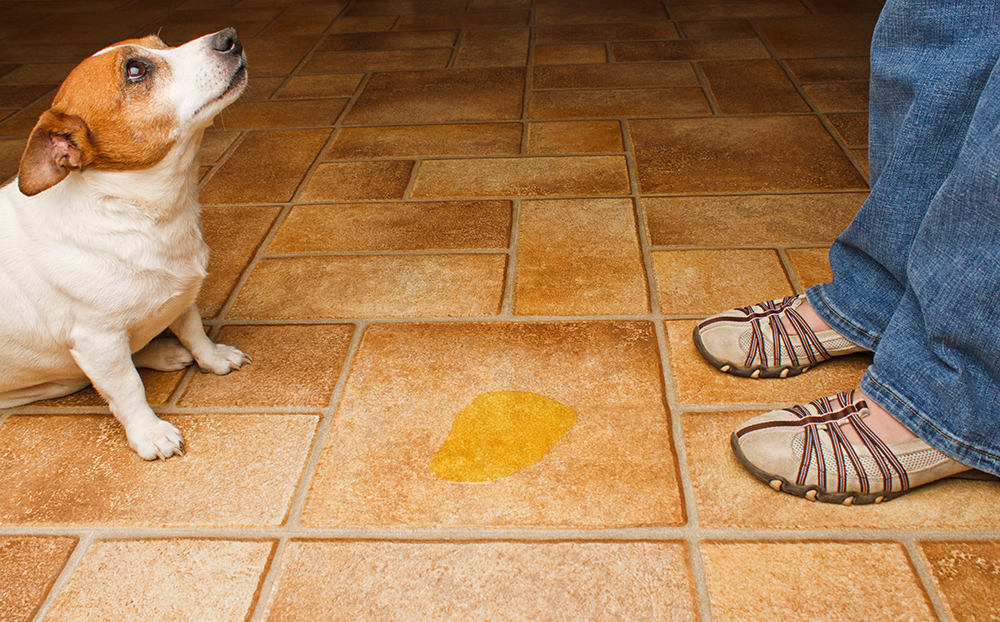 It is best to assume your new dog is not housetrained and move forward accordingly. You have an obligation to teach household rules, house train your dog, and monitor your new addition throughout the house until they understand what you expect. It is best to assume your new dog is not housetrained and move forward accordingly. You have an obligation to teach household rules, house train your dog, and monitor your new addition throughout the house until they understand what you expect.
|
Successful housetraining of older puppies and adult dogs requires a schedule, a routine, and a leash – the same equipment you’d use for a young puppy. You should take the dog out in the early morning, before bed, and after meals and naps. Attach the leash, take the dog to the same spot every time and consistently reward good behavior with a treat. Later, much later, after the dog has adjusted, you can let the dog out in the early morning and before bed and eventually trust the dog to alert you at other times.
Notes of caution: Many dogs have intestinal distress problems when adjusting to new situations. You should give this type of dog some leeway and never scold if the dog has accidents in the house. Dogs that have spent their previous lives in a kennel with concrete floors or on city streets or without access to outdoors will likely take time to learn to relieve themselves in a typical yard with grass.
The dog will probably not be crate trained: A crate can keep a dog out of trouble when you can’t supervise his activity, but most rescue dogs are not crate trained. If you force these dogs into a crate, they may panic and whine, paw, bark, or attempt to escape and may injure themselves or destroy the crate. Leaving dogs to “cry it out” is cruel. Instead, use this slow but sure process and gradually they will begin to adapt to the new confinement and settle in comfortably.
Place a few treats in the crate and permit the dog to check it out. If the dog is allowed to enter and leave at will, the dog will begin to see the crate as a place of comfort and security.
Another suggestion is to feed the dog in the crate but don't close the door.
Encourage the dog to go into the crate for rest when tired and close the door for only a few minutes, then open the door again. Eventually, with positive reinforcement rewards you will be able to teach the dog to enter the crate on command and leave the door open.
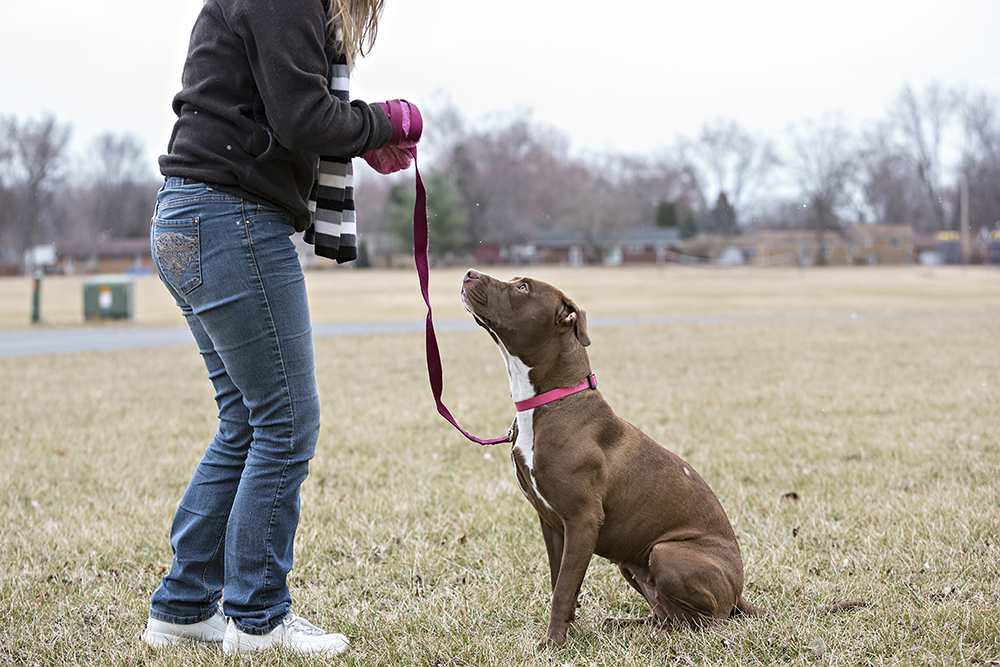 Be prepared to teach your new dog basic manners! Be prepared to teach your new dog basic manners!
|
Be prepared to teach basic manners: Obedience training especially the "sit," "down," and "stay" commands will provide you with a method of control until the dog learns the rules and becomes more trustworthy. Shouting “NO” doesn’t teach dogs anything; if the dog is unruly, guide the dog to more acceptable behavior, giving a treat when the dog obeys. Contact AKC Good Dog Helpline for help.
Also see this link for a number of videos that will help you in basic training: http://www.howcast.com/guides/1025-how-to-teach-your-dog-tricks/
Most dogs will come to you if you crouch down, clap your hands and say, “come here boy!” This game is the beginning of teaching the dog to come on command.
A leash is helpful in teaching dogs to come when called, but some dogs may panic, pull, struggle, back up and slip their collars and possibly escape if they are not accustomed to leash pressure. Do not use a choke collar, slip collar or prong collar on a frightened dog; the dog may freak out from the pressure of the collar, struggle madly, and injure themselves or they may even attack you in a struggle to escape.
Training an adult dog to accept the leash and collar is similar to training a puppy. You start with a sturdy flat collar that fits the neck but is not so loose it can slip over the head. Attach a leather or nylon leash (no chain link leashes or retractable leads!) and allow him to drag it around. When he has adjusted to the feel of leash and collar, pick up the leash and “follow the dog” without exerting pressure against the collar. Let him lead the way, if he goes in the wrong direction, bring him back by calling or offering a treat or a “nice dog” petting. Eventually, call him to you, and give a treat, then stand, show another treat, and encourage him to follow you while you back up holding the leash. If he stops or backs up, you stop or follow without putting any pressure on the leash. If he follows you, reward with the treat and an enthusiastic “good boy!” If he panics or struggles, move toward him, reassure and “change the subject” from the panic by talking or petting while you hold the leash without pressure on the collar (be careful to avoid rewarding the panic or struggle with your attention – you want to reward the change of his focus, not the unwanted escape or struggle behavior). You can encourage him to follow you and learn to walk on a leash in less than 15 minutes if your timing is good and the dog has not been traumatized by leash corrections in the past.
To solidify these initial steps, let him drag the leash around the house when you can supervise and occasionally pick up the leash and encourage him to come to you.
The commands to “sit” and “wait” or “stay” are an important part of good manners training. A dog that obeys these commands is a dog that waits for a meal or a treat instead of jumping up, doesn’t rush out the door, and remains in place while you put a leash or collar on. A dog that has learned that jumping up is not desired when not invited also less likely to jump on people for attention and more likely to stop jumping when given the commands. It’s also important to note that if more than one person is in the household, the behaviors that are not desired, i.e. jumping on people, must be enforced by all – otherwise, if one person permits it, the dog may conclude that every new person who shows up must be tested to see whether jumping up is OK or not.
To teach “sit”: Hold the leash in one hand and a treat in the other. Show the treat, then hold it a few inches above his nose. If he sits to see the treat, give it, praise and reward. If he doesn’t sit, keep the treat slightly above his head and slowly move it back toward his rump (don’t walk toward him if he backs up; if he backs up, bring him back to you with the offer of the treat and start over). Many dogs watch the treat and automatically park their rumps on the floor as you move the treat toward their back end. If they sit, praise and reward. Repeat 2 or 3 times, stop on a successful effort and call it a good session, to be repeated again later in the same day or the next day.
If he jumps up, keep the treat out of reach.
If he backs up to watch the treat, use a wall or other barrier to stop him. (Don’t scold; you might want to teach him to back up as a trick later and scolding for doing so now will confuse him when you’re ready to start that lesson.)
A rescue dog from the streets or from a home that failed to teach manners may have several behaviors that are natural for him but not appropriate for you. He may jump on people, get into the trash, chase the cat, bolt out the door, sit on or chew the furniture, or commit many other transgressions. Teaching, “sit,” “down,” “come,” and “stay” will give you some control over these behaviors because the dog has to stop the bad behavior to obey and get his reward. Don’t expect too much, too soon, though, and manage the dog to minimize occasions for unacceptable behavior.
Confinement: You should supervise your rescue dog when he’s off-leash until you know he will not climb, jump, or dig his way out of a fenced area, and you should never let him loose in a large fenced area such as a dog park unless he will come when called, even with distractions present.
Visible fences are best for rescue dogs because they are harder to escape than underground radio-collar fences. Dogs that are frightened or are hot on the trail of a cat or squirrel will bolt through an underground fence collar correction and then be reluctant to return (if they even know where to return!). The height and materials of a visible fence depend on the dog’s size, ability, and breed-specific behavior. Generally speaking, the dog should not be able to jump out of, climb over, squeeze through, or dig under the fence.
Some dogs are adaptable; even if they are unfamiliar with outdoor confinement, they understand the fence is a barrier and respect it. Others, especially dogs accustomed to running loose, may investigate the fence in search of an escape route. Some of these dogs sniff along the bottom of the fence and start to dig if they find a hole or a weak spot. Others will eye the height of the fence, and in an amazing display of agility, they will vault or climb up and over.
Gates can offer opportunities to escape even if they closed. You should check that latches are secure so the dog can’t spring them open by jumping at the latch itself or bouncing off the gate. Also be aware that small dogs can slip under or dig under a gate mounted over the earth with no solid threshold base, or they can squeeze between a fence post and the gate.
The rescue dog should wear a collar and leash with an identification tag even on your fenced property. The first time he goes out into the yard, you should walk him along the fence line and pay attention to any areas he challenges or investigates as they may represent potential escape routes.
After the first few walks around the yard, drop the leash and allow him to investigate the yard on his own. Keep an eye on him and if you see him jumping up or eyeing the height of the fence, walk to him, pick up the leash and correct him with a verbal reprimand (“No!” or “uh-uh! will work) and a quick tug-and-release on the leash, then walk him away from the fence.
Keep the leash attached to his collar when he is outdoors until you have determined he won’t challenge the fence. If he should escape, a dog dragging a leash will attract attention and perhaps aid in his recovery. His identification tag will allow anyone who catches him to contact you. The microchip will enable electronic identification if caught by most authorities or if he is taken to a vet.
Is the dog safe around children? Unless you know the dog was good with children in his previous home, you should assume that he could harbor suspicion or aggression toward all children or to a specific age group of children. If the children in his previous life treated him roughly, took his toys, teased him, or hugged him too tightly, he may be wary of, or hostile to other children of the same age or sex.
Yelling, screaming, and rough play among children can stir up a dog’s protective instincts or send him into a panic. Adopters should, therefore, be extra cautious about bringing home a dog that might have an exaggerated sense of protecting the children in his own family or a magnified fear of rowdy play, for some of these dogs may have snapped at or bitten unruly children who visited his previous home.
No matter what the rescue group or shelter staff may tell you about the dog, you must supervise his interaction with children. This means protecting the dog from the kids and making sure the dog does not have an opportunity to get riled or frightened. It is important to understand that most dogs cannot tell whether family members are wrestling in play or engaged in mortal combat. Their reaction to their owners’ physical engagement is often distress; they may feel compelled to “step into the fray,” leading to scratches, bites or other unfortunate consequences. In short: don’t wrestle in front of your dog. They won’t understand it.
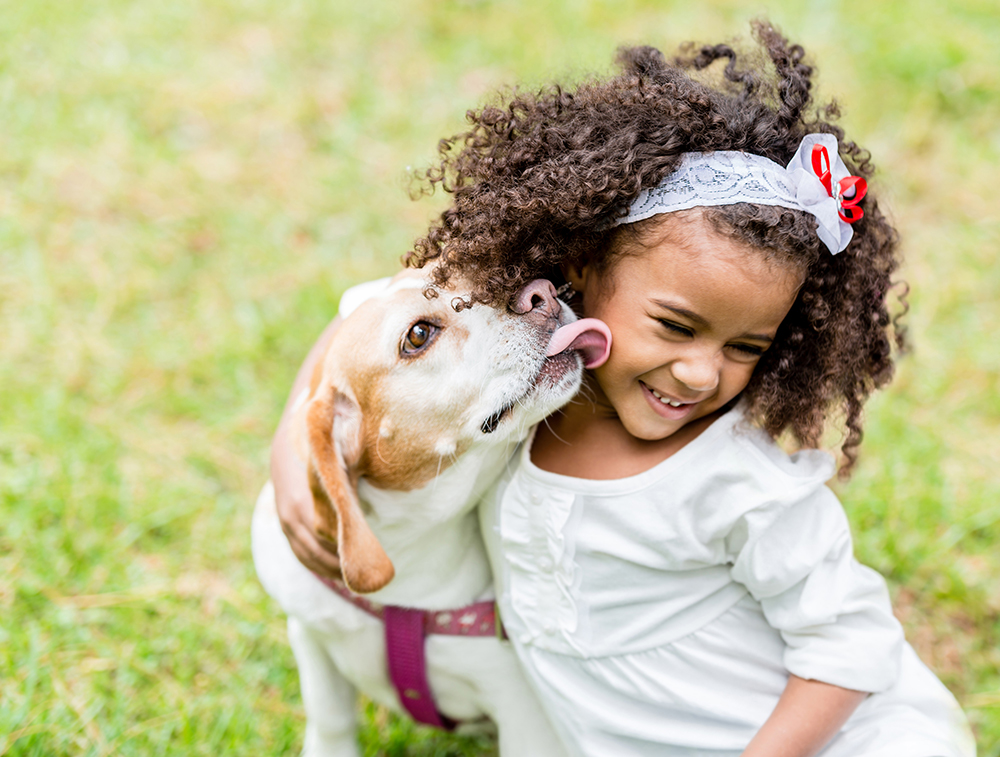 Many dogs love kids and vice-versa! But for the safety of dog and children, it is essential that interactions are supervised by a responsible adult. Many dogs love kids and vice-versa! But for the safety of dog and children, it is essential that interactions are supervised by a responsible adult.
|
For more information about dogs and children, check out the following links:
Dr. Sophia Yin's animal behavior website: has posters to download and discuss with your children.
“Kids and dogs: Safety first” includes a list of nine guidelines for keeping kids and dogs safe at http://www.canismajor.com/dog/kidsdog1.html
Living with kids and dogs...Without Losing Your Mind by Colleen Pilar is a great read before getting a rescue dog or a new puppy.
The dog will not be in the best of health: Stress, poor nutrition, lack of veterinary care, spaying or neutering, genetics, and a host of other factors contribute to a dog's physical and mental health. Puppies are pretty much a clean slate because they haven’t yet had enough bad experiences to make them wary or frightened, but adult dogs have a life history that could include illness, poor housing and care, poor nutrition, injury, or any of a number of other stresses that can compromise immune systems and affect behavior. These dogs will probably need immediate veterinary intervention unless the rescue or shelter took care of their medical needs prior to adoption.
Like all living beings, dogs are the products of their genetics. Although researchers have developed tests to identify many conditions that are genetically caused or influenced, the tests are expensive and few people outside the fraternity of show and performance dog breeders regularly use them. Therefore, it is highly unlikely that the owners of your rescue dog’s parents tested for any of the hundreds of genetic conditions that all dogs — purebred, mixed breed, and mongrel — are subject to.
If your rescue dog is purebred, it is highly unlikely that he came from a breeder who takes advantage of testing and breeds only the healthiest dogs. If your dog is a mixed breed or mongrel, the genetic picture is even more muddled, for contrary to media hype and activist claims, mixed breeds and mongrels are tested less, and not healthier than purebreds in any way. Just like people, all dogs are affected with genetic faults, some more serious than others.
If you have a purebred dog, look online for the national parent club at AKC or UKC. (see: http://www.akc.org/ or enter the dog’s breed and the word “club” in the search box). The breed club website lists the most common health conditions that affect that breed. Try to identify the mix of breeds in your mixed breed and then go to parent clubs for those breeds and do the same search. This will give you some idea of the common genetic problems and a heads up in helping identify potential or existing problems in your dog.
Do the research before you decide to adopt the dog so you can be prepared to provide the care the dog may need. For example, hip dysplasia, a painful condition that can require lifelong medication, physical therapy, and expensive surgery, can be a problem in any dog weighing more than 50 pounds.
Genetic abnormalities are not the only potential problems faced by adoptive families and their new pets. Dogs that have lived on the streets often have compromised immune systems caused by malnutrition, parasites, allergies, and long-term bacterial infections, and these can be difficult and expensive to treat. Medication may control these diseases and prevent recurrence, but many are chronic. Skin and ear infections, internal and external parasites, flea bite allergies, mange, and other conditions often plague dogs rescued from city streets and neglectful situations.
Some shelters and most purebred rescue groups make sure the dogs are healthy prior to placement with a family, but others do not have access to good veterinary care and a few are more interested in sending dogs out the door than in providing appropriate medical attention.
It is a good idea to take your new dog to a veterinarian for a physical even if the rescue organization gives you a vaccination and worming record, medication for a minor problem, or a health certificate. This first visit helps establish an important relationship with your pet’s doctor and allows you to ask questions about the worming done by the shelter, pick up heartworm medication, and discuss any health conditions that concern you. And if the shelter veterinarian spayed or neutered your pet shortly before adoption, you can ask the vet to check the surgical site and make sure it is healing properly.
Temperament checks are more difficult to do than general health checks because the dog may exhibit abnormal behaviors triggered by the rapid changes in his environment. You may have to depend on the temperament assessment done by the shelter staff and volunteers to decide if the dog will be compatible with your family.
Many shelters use some sort of temperament test before offering a dog for adoption, but shelters that import strays and street dogs may place the dog within days without either a temperament test or general health check.
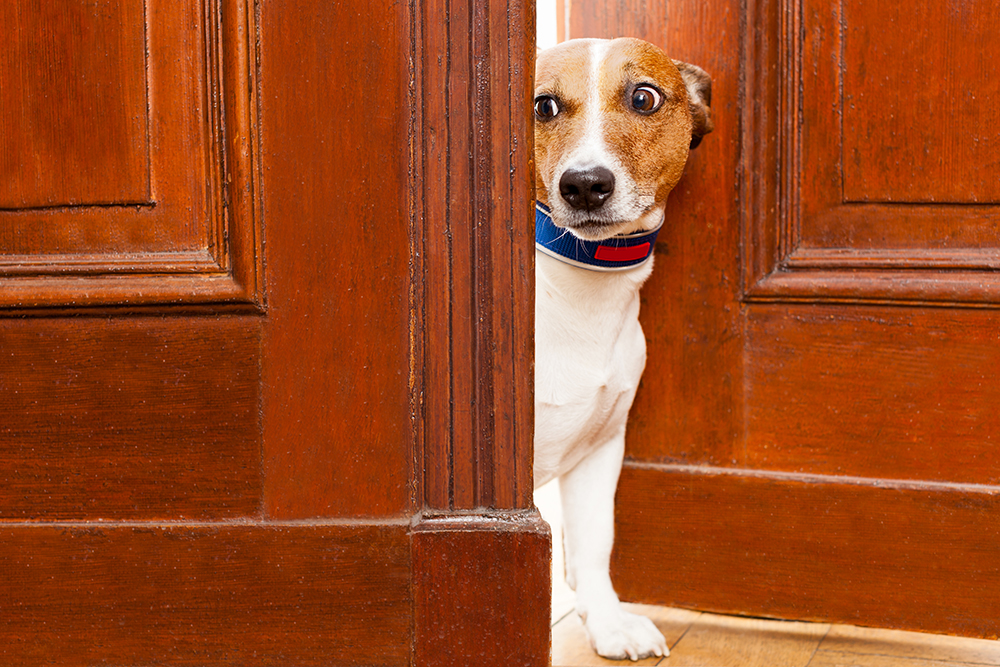 A neglected or abused dog may be fearful or shy at first. A neglected or abused dog may be fearful or shy at first.
|
The dog may not be mentally stable at first: Experience makes the dog, and removing him from one situation – even a cruel or neglectful one – will likely cause mental upset as he learns to cope with new people, surroundings, scents, sounds, and other animals. Even something as simple as walking on grass can freak out a dog that has lived in a kennel all of his life. A dog accustomed to fighting others for his dinner may guard his food and growl at other animals or people who come near. A neglected or abused dog will likely be fearful or shy, and one that has lived in or around his own excrement dirt will be tough to housetrain. A neglected dog may also fear fireworks, thunderstorms, and other loud noises, hate grooming, dislike boisterous children, refuse to have his nails clipped, or even growl or bite when frightened.
It would be ideal but probably not practical to get an independent evaluation from a professional trainer, behaviorist, or other person knowledgeable about dog behavior in general and breeds quirks in particular before committing to the adoption. However, the best most people can do is attend obedience classes or work with a private trainer after the dog comes home.
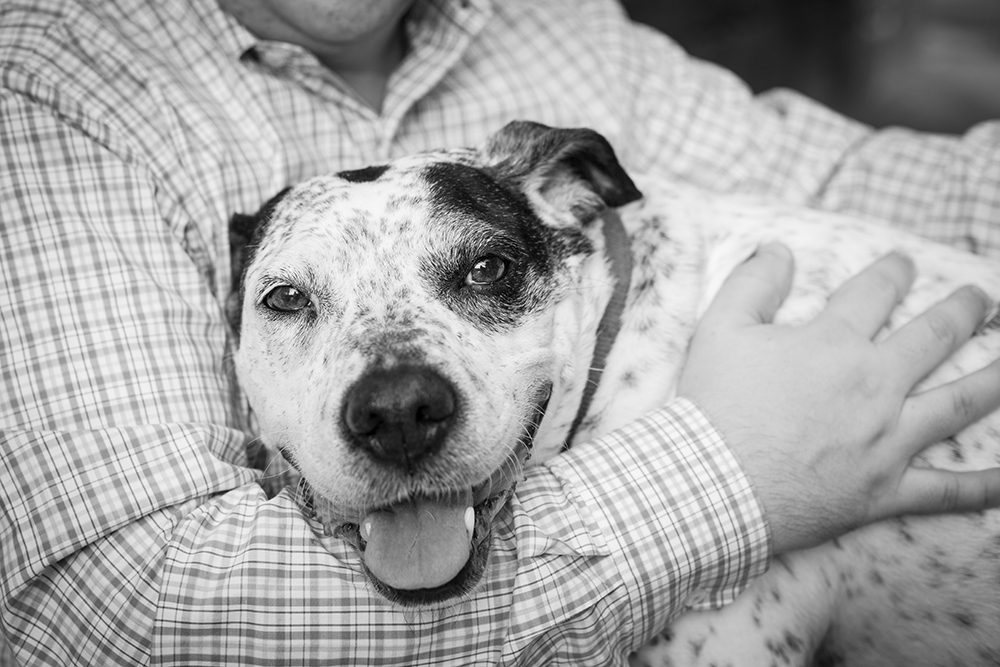 A rescue dog can be a joyful addition to your home. A rescue dog can be a joyful addition to your home.
|
The rescue dog can be a joyful addition to your home: With all of its inherent problems, participating in rescue can nonetheless be rewarding and satisfying. If you prepare yourself and your family to solve problems just as you would prepare for preventing problems with a puppy, a rescue dog can bring companionship and love into your home for you and your children.
One last note: Training is great fun and can help a dog overcome fear, shyness, neglect and cruelty. It is also a vital force in developing and improving the treasured connection between the dog and his people. It may be rough at first as the dog adapts to his new situation, but the rewards are beyond awesome.
A bonus: If you’ve a mind to further your partnership, rescue dogs can participate in almost as many dog activities as purebred dogs. Mixed breeds, mongrels, and purebreds of unknown ancestry can train and compete in obedience, agility, rally, flyball, freestyle dance, dock diving, and weight pulls, and can earn titles, ribbons, and awards. Even if these activities aren’t your thing, rescue dogs can learn to help around the house by fetching and carrying tools and toys, finding children who are hiding, and barking to warn about strangers. They can camp and hike with the family if they have manners; pull a garden cart if they have the structure and strength; and herd sheep, hunt game birds, or chase vermin if they have the necessary instincts to learn these jobs.
There’s no doubt that rescue dogs can offer a lifetime of pleasure.
The dogs that people acquire from their family members, friends and neighbors are often overlooked as a significant source of dogs in the pet marketplace, but numerous studies show that this is a major source of both adults and puppies.
When owners face lifestyle changes that make it difficult for them to keep and care for the family dog they often turn to people they know to rehome their dogs. They feel safer and more responsible transferring their dogs to them rather than taking the dog to a local shelter.
Dogs from this source run the gamut from healthy and well socialized to parasite-ridden basket cases, and everything in between. It is important to assess any adult dog carefully to determine the dog’s behavior and health status before accepting the responsibility.
Puppies from this source generally come from “oops” litters, from litters that were bred to let the family dog have one litter before spaying or from litters that were bred in the hopes of making a little money. Generally speaking, what these litters have in common is that they are all produced by dog owners with little knowledge of dog breeding and/or successful placement practices.
Pet owners who breed or allow their family dog to breed once or twice in the dog’s lifetime add greatly to the overall source of dogs available in the public, but despite their annual contribution to the national dog population statistics, they should not be called or thought of as breeders. They are not. They are simply pet owners whose dogs have puppies.
On the other hand, people who routinely breed their dogs and do so without getting the education and resources they need to do it right can rightfully be termed, casual breeders, also known disparagingly as backyard breeders. This is the category of breeders that most often gets in trouble, especially when the number of dogs they keep grows beyond a number they can properly care for. Read more about casual breeders below.
Link to text further up
 Breeders take an active role in preserving and protecting domestic animals — especially dogs!. Breeders take an active role in preserving and protecting domestic animals — especially dogs!.
|
People have taken an active role in animal breeding for thousands of years. In fact husbandry is part of our evolutionary history and almost instinctual. Pets help us maintain this natural and long-standing association, which has become more challenging as our population shifted over time from farms to cities and dangerous and nuisance dogs along with surplus shelter pets became common problems. Because of these and many other problems, today's breeders need to educate themselves about dogs, about specific breeds, and about socializing and training. They also need to plan each breeding decision to ensure positive outcomes for their puppies and must be prepared to take back dogs and offer advice on socializing, training and various other dog care issues in order to assure success. Those who are unable or unwilling to spend the necessary time and effort to make informed decisions, carefully place puppies, and maintain contact with puppy buyers should leave breeding to those who have the dedication to do so.
The importance of choosing the right breeder: A puppy will live with a family for a dozen years or more, so selecting just the right breed and breeder can be critical to initiating and developing a strong bond with the dog. Although any dog may become a valued and well-loved pet, well-bred purebred dogs have an advantage over mixed breed dogs because of their predictability: their size, coat type, exercise needs, energy level, trainability, and temperament can be predicted within a narrow range, thus allowing prospective buyers to purchase a puppy to match their lifestyle and living conditions. Well-bred purebred dogs are carefully bred to the standard of their breed. Dogs that do not meet the breed standard for these characteristics may not be suitable for individual situations. For example, Golden Retrievers and Labrador Retrievers are often acquired because they are known for being easily trained, enjoying an active life, and loving children, but a poorly-bred dog of either breed may be hyperactive, bull-headed, and snappish, or have other inherited behavior or health characteristics that make it a poor choice for a family. Thus, selecting both the right breed and breeder is crucial for success.
Once the breed is selected, the search for a puppy can begin. To recognize the differences between breeders and other sources that sell or place dogs with the public, the following categories may be useful. Like all attempts at labeling, the categories that are described below represent generalities that won't be true for every case. Puppy buyers are urged to do their homework and use a good measure of common sense.
So what is a breeder? In the most basic sense, the word “breeder” can be and often is applied to anyone who has a litter regardless of that person’s knowledge, experience or commitment to the health and welfare of their dogs or to the families who acquire their puppies. Nearly 50% of US households keep dogs, so it is inevitable that a fair number of puppies sold in the US are produced by pet owners with no particular knowledge of breeding.
Therefore when discussing breeders it’s important to determine upfront what sort of breeder you are talking about, a casual breeder with little knowledge of dogs or husbandry, a commercial dog breeder who breeds dogs for a living; or a breed enthusiast/hobby breeder whose priority is the improvement of their chosen breed. Generally speaking, breeders can be divided into two categories:
non-commercial breeders, and commercial breeders:
Non-commercial breeders fall into two categories: 1) breed enthusiasts, including dogs bred specifically for their ability to perform a certain job, hunting, for example; and 2) casual breeders who dabble in breeding or breed without properly educating themselves. Commercial breeders include breeders selling directly to the public from their facility or indirectly; for example, over the Internet sight unseen and/or to pet stores.
Breed enthusiasts (also known as show breeders, purebred dog fanciers, hobby breeders and responsible breeders) who follow breed club guidelines and codes of ethics are a top choice as a source of purebred pet puppies. Breed enthusiasts are motivated by several factors: Love of a breed; a desire to contribute to the improvement of breed health and performance skills; enjoyment of breed competitions and sports; and enjoyment in the company of other breed and dog admirers. Breed enthusiasts who join dog clubs breed for health, temperament and breed type; screen their breeding stock for genetic abnormalities; become knowledgeable about breed history and bloodlines; provide appropriate health care and housing for adult dogs and puppies; raise, train, and socialize puppies in their homes; participate in dog shows so their dogs can be evaluated for adherence to specific breed standards of excellence and for performance ability; and help with public education efforts promoted by national and local dog organizations. Breed enthusiasts are sometimes called "responsible dog breeders."
The hallmarks by which these breeders can be recognized are:
Responsible breed enthusiasts producing animals for show, work, or pets as a hobby or an avocation are more than happy to oblige potential clients. Prospective buyers can see where litters are raised, talk to the breeder about health clearances and socialization, and meet the dam of the litter. Responsible breed enthusiasts also help buyers select the best puppy for their circumstances, often decline to place puppies of high-drive dogs in laid-back pet homes, and remain available to help buyers after they take the puppy home.
 Passionate about dogs, breed enthusiasts care for dogs literally from birth, and learn everything they can about their chosen breed! Passionate about dogs, breed enthusiasts care for dogs literally from birth, and learn everything they can about their chosen breed!
|
Passionate about dogs, breed enthusiasts take the time to learn everything they can about their chosen breed. They participate in kennel clubs that hold dog shows and educate the public about dog care in general and breed behavior, health, and dog sports in particular. They take part in breed, obedience, and field events to prove the mettle of their dogs and share the love of dogs with other breeders and owners; attend seminars to expand their knowledge of canine health and training, and serve as mentors to breed newcomers. They register their dogs primarily with the American Kennel Club, the United Kennel Club or a specific breed registry. They take back dogs if buyers can no longer keep them, and they keep retired breeding and performance dogs if they cannot find a good pet home for them. Many breed enthusiasts also help with the rescue of their breed with donations of time, space, or dollars and contribute to research into inherited canine diseases personally and through their local and national clubs. The American Kennel Club, the organization that most responsible breed enthusiasts use to register their dogs, has donated more than $24 million to promote canine health.
While responsible breed fanciers take pride in producing high-quality show and working dogs, they also desire to place healthy puppies and adult dogs as pets in suitable homes. The relationship doesn't end when the puppy goes to its new family; responsible breed fanciers keep in touch with buyers, answer questions about training and behavior, and enjoy the thriving relationship between the dog and the family.
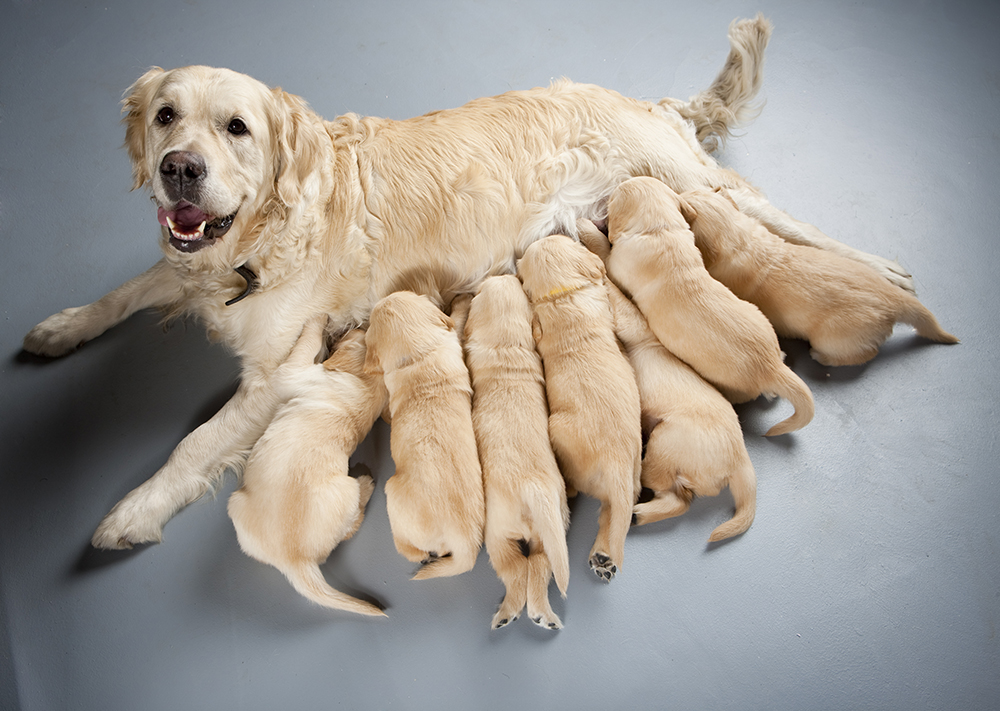 Every puppy in this litter will be placed in a good home! Every puppy in this litter will be placed in a good home!
|
Although they may have a small kennel on their property, most show and performance dog breeders raise puppies in their homes to expose them to household sounds, sights, and smells. They also start house training and begin puppy vaccinations, worming, and socialization. They try to match each puppy with each family or individual so that everyone will be happy with the choice. They explain breed behaviors and needs so that families aren’t surprised when the puppy acts like a watchdog or guardian, herds the kids, or chases other animals. And they keep open channels of communication so that buyers can ask questions about training, behavior, and health as the puppy grows.
Of course, these practices do not guarantee perfect health for a breeder’s dogs. Just like human families, some dog breeds are more prone to specific diseases than others. But the time and effort spent by good breeders to assure the health and socialization of their puppies goes a long way toward increasing awareness and reducing the risks!
Prospective buyers can find these breeders and their clubs through the American Kennel Club's website, or through a local kennel club website. The United Kennel Club also has a breeder-finder portal.
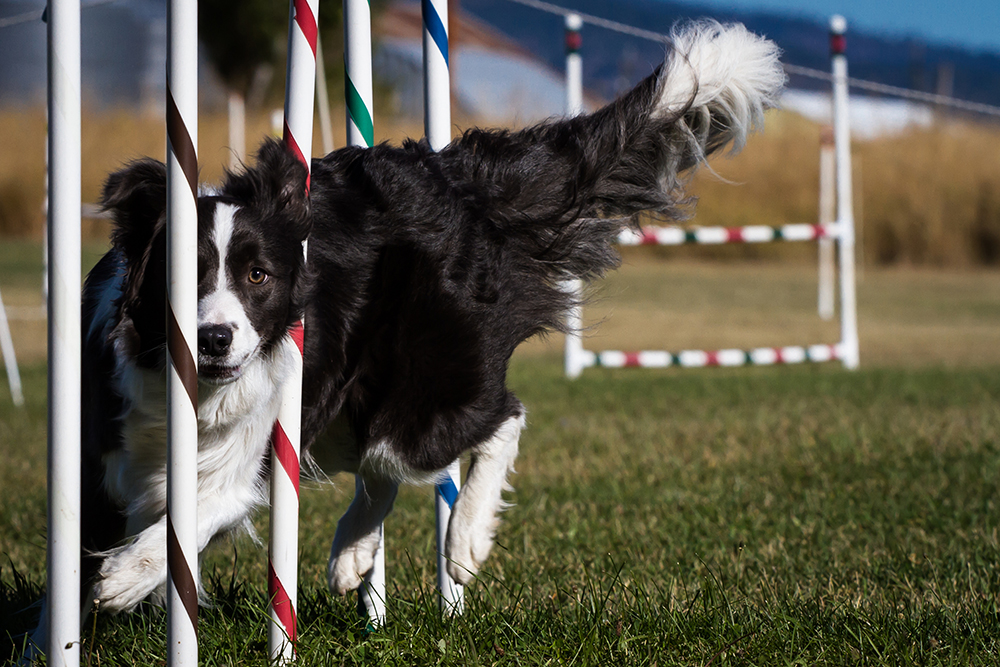 Performance dogs are bred primarily to do a job or participate in a sport, such as guarding livestock, field trials, or sled dog racing. Performance dogs are bred primarily to do a job or participate in a sport, such as guarding livestock, field trials, or sled dog racing.
|
Performance dog breeders are a subset of breed enthusiasts that include individuals and organizations that breed dogs primarily to do a job or participate in a sport, field trials, sled dog racing, and others who participate in canine sports. They breed dogs for the temperament and ability to serve as working companions for owners with disabilities or produce hunting dogs, herding dogs, guard dogs, racing dogs, sled dogs, and dogs with the temperament and stamina to participate in Schutzhund and other sports. These breeders concentrate on health and ability in producing high-energy, high-drive dogs that are good at their jobs but which may not always be satisfactory as family pets because of their Type A, workaholic personalities. Therefore, responsible performance dog breeders take extra care in placing their puppies as pets.
Performance dog breeders have contributed volumes of information to canine health and training and to an awareness of canine behavior and history. From the USDA project to determine the value of certain breeds as livestock guard dogs to the in-depth understanding about training and behavior from service dog organizations and the studies of structure and health in sled dogs and racing dogs, these breeders have coordinated efforts with veterinarians and other professionals and thereby greatly enhanced the base of knowledge about dogs.
Performance dogs love to do what they do. They run because they want to run, not because they are forced to run. They herd and guard livestock because they are suited for the work and naturally attracted to it. Great Pyrenees will live with the flock 24/7 if given the option. They help people because they are rewarded for their behavior, not because they are enslaved. They hunt because they are well-adapted to scenting and sighting game and would do so whether domestic or wild. Our members appreciate the beauty and splendor of dogs performing according to their nature and applaud those breeders and others who responsibly produce, study, and train these dogs.
Most serious breeders of show and performance dogs are members of an AKC or UKC national breed club that promotes and protects their breed. Known as breed parent clubs, these organizations keep track of (and raise money for) breed health education and research; provide breed-specific information for new and prospective owners; offer awards for breed and owner accomplishments in a variety of activities; and host breed-specific events, including an annual National Specialty show and various performance events.
Virtually all parent clubs have a code of ethics, some so long and detailed that they reach the size of a novella, Newfoundland Club of America, or Golden Retrievers while others go straight to the point , only a page or two in length (French Bulldog Club of America, or German Shepherd Dog Club of America, It is always a good idea to check out a club’s code of ethics because it speaks to the core values of its individual members.
Most breed clubs have or work with a rescue committee or organization that helps dogs of that breed find a new home if necessary. The dogs may be pets whose owners cannot care for them any longer, pets purchased without knowledge or consideration for breed-specific traits, unredeemed strays from shelters, retired breeding dogs, or dogs confiscated by authorities in legal cases. These groups generally operate without a central facility, instead depending on volunteers to foster, evaluate, and, if necessary, bring dogs back to health or teach them basic manners before presenting them for adoption. The AKC has a list of parent club rescues at http://www.akc.org/breeds/rescue.cfm.
Home breeders of show and performance dogs: A further subset of breed enthusiasts under the performance dog breeder category, these specialized breeders are in-home enthusiasts, generally registering dogs with the American Kennel Club or the United Kennel Club (or both). They are knowledgeable about breed history and temperament, participate in competitions to prove their dogs are worthy examples of the breed, take advantage of breed health screening tests, and belong to dog-related clubs (including a national breed club). They donate to canine health research on their own or through their clubs and often volunteer their time to teach obedience classes, participate in community education events that support responsible dog ownership, and they help rescue or shelter dogs. Above all, they are passionate about the breeds they own and the puppies they produce.
Special Considerations when buying a pet from a breed enthusiast/hobby breeder: Unfortunately, it’s easy to fall into a mindset of “Oh, it doesn’t matter where we acquire our dog, we just want a pet” when looking for a puppy. However, there really is no such thing as “just a pet.” Good breeders want all of their puppies to go to good homes regardless of whether they will be show dogs, working dogs, therapy dogs, or pets. They give all of the puppies the same start in life, selling some puppies on no-breeding contracts if they aren’t quite right for a breeding program but are exactly right as a family pet. http://www.ncanewfs.org/working/working.html#.V2dxfLgrLtQ
Dogs are not “Johnny-one-notes” with limited repertoires, and good breeders want every puppy they sell to get the love and attention of a family companion even if it will fill other roles as an athlete, a search and rescue dog, a therapy or service dog, or a breeding dog. Millions of dogs are multi-purpose: they go from show ring to whelping box to therapy visits to the hunting field to agility or obedience training without skipping a beat. Indeed, many breed parent clubs offer certificates of achievement for dogs that complete tests that mimic their original purpose and proudly recognize this versatility at their annual meetings or on their websites.
Examples:
The Newfoundland Club of America offers working dog and versatile Newf recognition for multi-talented dogs of the breed. Along with AKC events, the club honors dogs that do the traditional breed water rescue work and draft work.
The Samoyed Club of America offers titles in several areas, including draft work, herding, and sled racing, all jobs that Siberian natives expected their dogs to master.
The Labrador Retriever Club of America offers working certificates for dogs that successfully complete land and water hunting tests.
The Canaan Dog Club of America offers both herding instinct certificates and versatility recognition for dogs of high achievement.
 Breed enthusiasts are sometimes viewed as a little eccentric, or perhaps even crazy for their chosen breed, but are widely respected for the love and hard work they put into their dogs! Breed enthusiasts are sometimes viewed as a little eccentric, or perhaps even crazy for their chosen breed, but are widely respected for the love and hard work they put into their dogs!
|
Of all the different sources of puppies, breed enthusiasts (hobbyists) have the highest standing with the American public. This is because the public associates certain practices and ideals with such breeders: their breed knowledge and experience, their commitment to canine health; their willingness to test their dogs’ quality and ability in shows or performance events; their placement practices; their long-term assistance to puppy buyers; and according to at least one (dated) scientific study, the overall satisfaction of their buyers.
It is important to keep in mind, though, that just like other sources of dogs, this breeder category has its own black sheep. While the majority of breed enthusiasts sign their national breed club’s code of ethics to adhere to these practices and follow them as a badge of honor, it is also true that some breeders who claim to be part of this group do not follow many of its most basic practices. They talk the talk but don’t walk the walk. They don’t do the genetic testing appropriate for their breed and they don’t assist their buyers after the sale. They may not even belong to their national breed club.
It takes a while to acquire knowledge in any profession or avocation and newcomers cannot be expected to reflect best practices right away. On the other hand, the puppies of breed enthusiasts are in high demand, so it is not unheard of for less scrupulous breeders to assume the trappings but not the practices of a breed enthusiast. The bottom line is this: If puppy buyers want the benefits associated with breed enthusiasts, they need to do their homework.
For starters, they should visit the AKC website and search for the national club of the breed they are seeking. Most of the national breed clubs offer breeder referral services. Puppy buyers should expect all the basics and more. They should receive the puppy’s vaccination and worming records plus information about the health testing conducted on the parent animals. They should ask about breed club membership, about warranties, return policies and ask to see an example of their puppy’s sales contract.
When buying a dog for agility, obedience, or conformation: The puppy’s structure is critical if you want a dog for any athletic pursuit. It’s not enough to have a pretty face or to look good standing still – sound physical structure is necessary for peak performance in athletic training and competition. For example, shoulder angulation, joint assembly, body length, and muscling all affect movement and contribute to a dog’s stamina, endurance, and ability to run, jump and turn without injury.
Each breed has a standard of excellence (called “The Standard”) that describes its physical traits and some of its specific desired behavior characteristics. Judges at conformation shows evaluate dogs according to their adherence to the breed standard, so if you want to participate in conformation shows and eventually may breed your dog, you need a puppy that is physically and mentally sound and has the structure, coat type, and other qualities set forth in that standard.
Conformation shows like Westminster, for example, are not just “beauty pageants.” In such shows, judges assess each dog’s movement looking for gait characteristics as described by the standard for that breed and they conduct a hands-on exam to determine whether it moves free of structural defects and otherwise meets the breed standard.
Advanced obedience competition and agility competition require dogs to jump. Agility also requires that the dog turns at speed, weaves through poles, climbs an A-frame and dog walk, and balance on a teeter. A dog with weak bones or joints, poor muscling, or an inflexible spine is at risk for serious injury in these canine sports.
A dog that is headed for a career in the show or performance ring also needs the attitude to be a successful competition dog. A good breeder will help the buyer select the puppy that not only has the physical prowess for training and competing but also has a willingness to learn and the attention span to cope with training.
When buying a working dog: Whether they’re guarding a flock of sheep, herding cattle, or searching for a lost hiker, it’s hard not to admire a working dog. Their high intelligence and drive make them attractive to a lot of people, but these very traits can create challenges for unprepared pet owners. A good working dog breeder is well aware of these challenges, and will ask why you want a working dog, what purpose will your dog will serve, and if you plan to provide opportunities for the dog to express his innate working traits.
Dogs bred for working are hard-wired to do a job, so it’s vital to know that the owner understands this need. Failure to provide a job is likely to end in disaster as many breed rescuers can attest. Dogs don’t know that the job they have now is different than the one they had in the breed’s ancestry, so owners can satisfy the need to work through training and competition in obedience, tracking, herding, hunting, and other disciplines. The important thing is to occupy the dog’s mind and body so it doesn’t become destructive or neurotic when left to its own devices.
2. Casual breeders
Casual breeders are the other category of non-commercial breeders who raise dogs in their homes and sell directly to the public. Known pejoratively as "backyard breeders," casual breeders breed litters so children or other family members can witness a birth; because they believe that a female dog needs a litter to be “fulfilled;” because they hope to earn a little extra money and haven't yet learned that litters often cost more than they bring in; and/or because they did not neuter their pets or keep them properly confined.
These breeders produce both purebred dogs and mixes. Typically they also raise their animals in the home where a puppy purchaser can see the dam and the conditions under which the litter was raised, but they generally lack the knowledge and experience necessary to make prudent breeding decisions. They almost certainly lack in-depth knowledge about breed conformation, temperament, and training and are often uneducated about general health and inherited diseases, normal and abnormal puppy and breed behavior, and training techniques for instilling good manners or correcting unacceptable behaviors. They are very unlikely to join clubs, participate in dog sports, attend seminars, help with public education efforts, contribute to breed rescue efforts or take back dogs if placements don't work out. For these reasons they usually cannot offer sound advice to their puppy buyers.
These casual breeders are often disparaged by anti-breeding activists, show breeders, and commercial breeders alike because too often they place parasite-ridden, unvaccinated dogs and contribute to irresponsible dog ownership. Because producing healthy, well-bred puppies requires in-depth knowledge and a professional attitude, casual breeders need to increase their knowledge of breeds and breeding so they can make good decisions or leave breeding to those who have the desire and understanding to pursue it as an avocation or profession.
A kennel is commercial if it breeds and sells puppies primarily as a business. A commercial kennel may have only a few dogs or dozens or even hundreds of dogs. Some sell puppies directly to the public from their facilities. Some sell to pet stores or to dealers who in turn sell to pet stores, and some sell directly through print or electronic media to consumers who do not see their puppy until the transaction is completed online and the puppy is shipped to them.
Commercial kennels with 5 or more breeding females, which sell dogs for resale in pet stores, over the Internet or through magazine ads are regulated by the US Department of Agriculture (USDA) under the federal Animal Welfare Act (AWA). Links to the AWA and AWA regulations can be found at the APHIS publications page found here) These kennels are inspected annually for compliance with a set of housing and care standards, including a plan for veterinary care. They can be fined or lose their operating licenses if they do not abide by these regulations. Further, puppies sold in pet stores possess AWA kennel license numbers that enable consumers to identify the source and inspection report of the source of a pet store puppy.
The best commercial breeders not only provide clean, safe kennels for their dogs, but they also provide appropriate veterinary care and treatment of their dogs, vaccinate and worm the puppies, and provide some handling and socialization before the puppies leave their facilities. A small but growing number of commercial kennels use health clearance tests to reduce the incidence of genetic diseases that are known to exist in the breed.
Several layers of authority may oversee operations in commercial kennels. Several states regulate the care and conditions that commercial breeders provide for their animals and conduct periodic kennel inspections to ensure compliance. The federal government licenses and inspects kennels that sell puppies sight unseen, or sell to pet stores and to other dealers, and it enforces a set of regulations promulgated by the US Department of Agriculture under the Animal Welfare Act.
Finally, AKC inspects all kennels that register more than six litters annually. AKC conducts thousands of in-kennel inspections each year, which are aimed at improving breeding and care standards. Field agents proactively help customers understand AKC’s expectations and help breeders reach higher levels of canine welfare. Kennel owners whose conditions have major problems lose their ability to register dogs with the AKC unless they correct the problems. AKC also conducts DNA screening to confirm dog identity and requires DNA identification of dogs that sire more than three litters in a year or seven litters in a lifetime.
Historically, the federal Animal Welfare Act regulated the commercial breeders that sold puppies to pet stores and exempted most other breeders from regulation. The creation of the Internet and its rapid commercial acceptance, however, completely changed the pet marketplace. Many breeders who formerly sold to pet stores were no longer required to be USDA licensed and inspected when they switched to selling their dogs over the Internet, a situation that left many large scale breeders unregulated. To address this situation, in 2013 USDA approved regulations providing oversight of these breeders. The new authority covers pet breeders who have more than four breeding females and sell puppies without a face-to-face meeting between seller and buyer. This rule prevents larger commercial animal breeders from selling pets sight-unseen without having their facilities inspected. It still exempts small breeders and those who sell directly to consumers on a face-to-face basis. For more information about the new regulations, see the NAIA analysis.
Commercial breeders seldom participate in dog shows, but they often join local, state, or national trade associations that offer guidance on kennel standards and work to upgrade the welfare of the animals in their industry. Many commercial breeders and pet stores belong to the Pet Industry Joint Advisory Council, an association that conducts animal care seminars and other events and works for reasonable animal welfare laws at the state and federal levels.
Commercial breeders register their purebred dogs with several organizations. The American Kennel Club is the best known of these registries. It conducts thousands of in-kennel inspections each year, which are aimed at improving breeding and care standards. AKC also conducts DNA screening to confirm dog identity and requires DNA identification of dogs that sire more than three litters in a year or seven litters in a lifetime.
Some people use the term puppy mill and commercial kennel synonymously implying that all commercial breeding is conducted in filthy, substandard facilities where animal health and well-being are neglected and breeding stock is abused. That is not the case. Many modern commercial kennels are state of the art facilities producing healthy, well-socialized puppies to sell to pet stores or directly to the public. A puppy mill is a derogatory term used to describe substandard, unacceptable breeding operations. Unfortunately, the term is often broadly applied to include breeders and kennels that operate responsibly, humanely and legally.
Negative perceptions continue because of the rough and virtually unregulated early history of the pet industry and because some large-scale, substandard operators continue to operate underground, evading current laws and regulations. The public confuses these illegal operators with the legally operating breeders and the pet stores they supply, giving the entire industry a bad reputation. Pet store puppies by law must come from USDA licensed breeders or from breeders who are exempt from regulation because they have 4 or fewer breeding females.
Consumers who are shopping for a pet store puppy can distinguish illegal from legal breeders in that venue by asking the store for the USDA license and inspection report of any breeder whose puppy they consider buying. Like pet store purchasers, buyers who purchase dogs through Internet or magazine ads cannot see the kennel, the parent dogs, or the litter and cannot select their own puppies. If these breeders have more than 4 breeding females, they are required to be federally licensed and inspected to assure compliance with minimum husbandry standards. Sight-unseen buyers should make certain that breeders they deal with are operating legally.
Buyers should be wary of a variation on pyramid schemes that make novice puppy buyers part of the kennel breeding program through contracts that require a bitch puppy to be bred once or twice to a stud of the kennel's choice and make puppies available for sale to the public. Such contracts allow the breeding kennel to expand its business at the expense of the buyer and his dog (and the magnitude of the expense may come as a shock to a buyer who becomes a novice breeder, even if offered guidance from the contracting breeder). Breeding stock should be carefully evaluated and breedings carefully planned, not required of novices by contract when a puppy is purchased.
Designer dogs: Some breeders produce crossbreeds and advertise the pups with marketing labels that include the names of the parent breeds. Many of these dogs are Poodle crosses, Maltipoos (Maltese-Poodle) and Labradoodles (Labrador-Poodles) for instance, but other breeds are also used. A Puggle, for example, is a cross between a Pug and a Beagle. Breeders often promote these crossbreeds as having the best traits of the parent breeds, but without the drawbacks. In asserting this, they benefit from the parent breeds’ popularity while disparaging them at the same time. But regardless of the marketing claims that are used to sell these puppies, i.e., that they are hypoallergenic, don’t shed, or that they are otherwise superior to one or both parent breeds - designer dogs are brands, not breeds, and therefore they are not predictable in type, temperament, size, activity level, health or trainability. The progeny of two distinct breeds can vary greatly.
Typically, designer dog breeders produce puppies for the pet market, not for a particular job or performance activity or for consistency in physical and mental traits. They can be large or small commercial breeders or casual home breeders producing an occasional litter for pocket money. Like any mixed breed, a designer dog can be a wonderful pet, but buyers contemplating acquiring one should heed the same cautions offered when choosing a breeder of purebred dogs: look for someone who pays attention to the health and welfare of parent dogs, takes advantage of genetic screening for common inherited diseases, provides references, answers questions about the puppies, begins a vaccination and worming program, and does not make extravagant assertions about puppy health.
Considerations when buying a dog from a breeder over the Internet: If a breeder has more than 4 breeding females and sells dogs sight unseen over the Internet or through ads in other media, they are considered commercial and subject to federal licensing and inspection. When considering a puppy offered over the Internet or other indirect means, it is vitally important to verify that the breeder is federally licensed. The difference between a legally operating licensed breeder and one who is required to be – but is not licensed, can be enormous. Most of the truly awful kennels shown on TV exposés are operating illegally and therefore avoiding federal licensing and inspections. Do not buy a puppy over the Internet unless you can verify that the breeder is operating legally, i.e., USDA licensed if they keep more than 4 breeding females.
 Do not buy a puppy over the Internet unless you can verify that the breeder is operating legally Do not buy a puppy over the Internet unless you can verify that the breeder is operating legally
|
Another challenge for consumers buying puppies over the Internet is establishing that the lovely puppies pictured on a website actually exist at the kennel. Ask for photos of the puppy you are buying before the puppy is shipped so there will be no surprises.
The new USDA rules require a face-to-face transaction, but that transaction can take place away from the breeders’ facility or home. Be aware that once you conclude an offsite sale of this type, it can be hard to get information from a less-than-scrupulous breeder if the puppy is sick or otherwise fails to meet expectations.
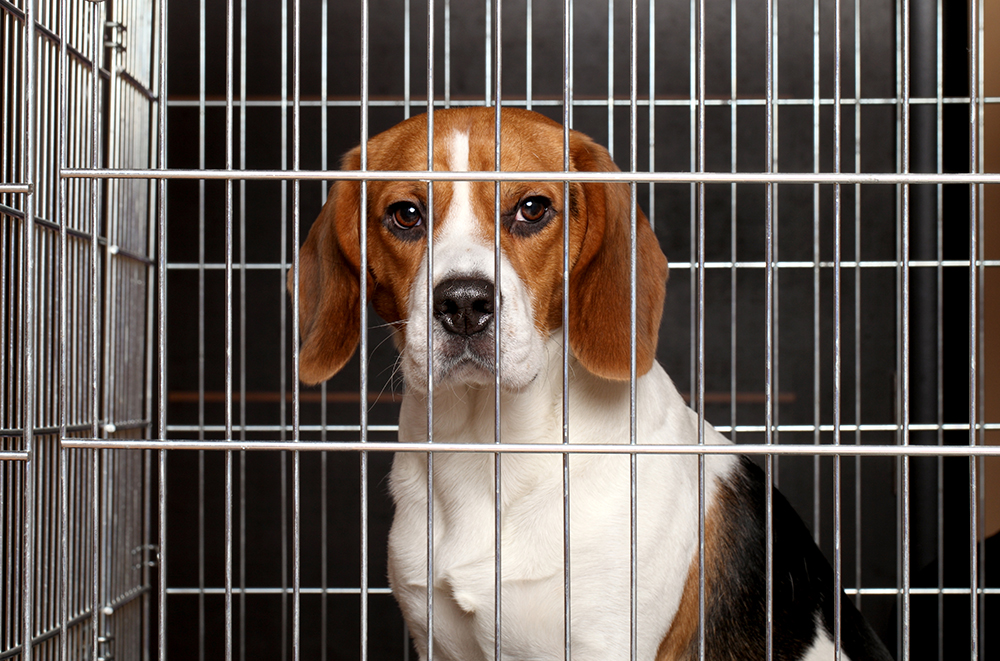 Not all pet stores are the same. Some do an excellent job, others lack transparency and focus little attention on animal wellbeing. Not all pet stores are the same. Some do an excellent job, others lack transparency and focus little attention on animal wellbeing.
|
According to numerous market research reports, pet stores are responsible for about 3 - 4 % of the puppies sold in the US. These retailers fill a niche for buyers who are looking for a puppy of a specific breed, often in areas where there are no private breeders with puppies of the breed they want. Even if there are reputable breeders in the area, there may be a long waiting list for a puppy of the breed they want.
By federal law, pet stores can only buy from USDA licensed breeders, or from breeders who are exempt because they keep fewer than 5 breeding females. Please read the information above about legally operating commercial breeders.
As with all sources of pets, pet stores are not all the same. Some do an excellent job. They purchase puppies only from breeders with proper management practices and animal welfare standards. They focus their attention on the health, welfare and behavioral needs of animals in their stores. They offer reliable customer service, including straightforward return policies and warranties. And they provide educational resources to help new puppy owners.
At the other end of the spectrum are stores that lack transparency and focus little attention on animal wellbeing, either in their purchasing practices or in the care they offer animals in their stores. Their customer service is shoddy and their return policies and warranties are ambiguous at best.
Due to the variability and range of pet store attributes, the challenge for prospective pet store buyers is to establish the type of the pet store they are considering. Until a few years ago, it was nearly impossible for consumers to determine whether or not a pet store puppy was from a humane breeder or from the sort of breeder shown in TV exposés. It was equally difficult for conscientious pet stores to distinguish themselves in any significant way that the public could easily understand. But that has finally begun to change.
In May of 2009 USDA began posting the inspection reports of USDA breeders online offering a level of transparency that had never before existed. These reports make it possible for the first time for the public to identify conscientious, humane and legally operating breeders who supply pet stores. Because most pet store puppies come from USDA licensed breeders (the others come from breeders with 4 or fewer females), this gives consumers a tool for helping them to evaluate the source of the pet store puppy they are considering.
Until the birth of the Internet and the emergence of large scale interstate rescue transporters, pet stores were the primary source of puppies that were sold indirectly, i.e., without consumers meeting and dealing with the breeder, seeing the related dogs and observing the home or kennel of origin prior to purchase. Now, they are one of many such indirect sources, and likely to be the most regulated of all of them.
USDA issues citations for both indirect and direct noncompliance issues (NCI’s). Indirect NCI’s are issued for small infractions, while direct NCI’s can be serious ones that indicate a situation that could harm an animal, such as unsanitary facilities, untreated wounds, lack of proper veterinary care, and other shortcomings that put animal health and welfare at risk. In the years since USDA began publishing this information, many pet stores and middlemen have begun using these reports to guide their buying decisions. Some pet store owners take it a step further and routinely visit the breeders they work with. Prospective pet store puppy buyers should get information about the source of any puppy they are considering, including a copy of the USDA inspection report.
The key for consumers is to understand how to distinguish a responsible pet store from one that is not. Here are some questions to help draw distinctions when evaluating a pet store prior to a purchase.
In addition to the USDA’s improved oversight, enforcement actions and their publication of inspection reports, many states have enacted their own laws to regulate commercial breeders. AKC puppies are further protected by AKC’s kennel inspections program and AKC’s Care and Conditions policy which raises minimum standards of care in kennels of all sizes and helps breeders stay current with best practices. Additionally, since 2014, animal scientists at Purdue’s Center for Animal Welfare have been working to develop science-based dog breeding standards for commercial kennels, which in April of 2016 are in a testing phase.
In conclusion, for the last 15-20 years, concerned individuals ranging from activists to pet industry leaders and animal scientists have been working nonstop to solve canine welfare problems in the pet industry. With regard to the pet store and its chain of supply, they have raised care and condition standards in breeding kennels, in transportation and in the pet stores themselves. There is more to do, but there is no question that their efforts have already led to gigantic animal welfare improvements.
Despite undeniable animal welfare improvements that have occurred and no matter how progressive and socially responsible a given pet store may operate today, anti-pet store activists continue to oppose all pet stores categorically, in large part because of the industry’s checkered history and the illegal operators who continue to operate despite pet industry and government efforts to stop them.
The best source of purebred dogs continues to be in-home hobby breeders where purchasers can see the parent dogs, count on basic health checks and observe the conditions under which the puppies were produced and reared. But when that isn’t possible, choosing a puppy from a pet store that buys only from licensed, inspected breeders, operates transparently, and offers a good warranty and return policies, can be a good second choice.
In summary, pet stores, like other sources of dogs, i.e., breeders, rescues and shelters are not uniform in their operations or the quality of the dogs they offer. They occupy a continuum ranging from excellent to unacceptable stores, with most falling somewhere in the middle. Some work very diligently to operate in a humane, responsible and transparent way, sourcing dogs carefully, handling them humanely in the store and providing consumers with healthy, socialized and warrantied puppies. At the other end of the spectrum, are those that operate without much regard to the source or quality of their dogs or inspection requirements, focusing more on the bottom line than on animal welfare and consumer satisfaction.
It is the responsibility of pet store customers to verify for themselves that the source of dogs offered is from a legally operating, humane breeder. They can do this by asking to see the USDA license number and inspection report of any breeder whose puppy they are considering. To summarize, they should assess the store’s overall animal handling practices; the professionalism of its staff, its transparency and the quality of its warranties.
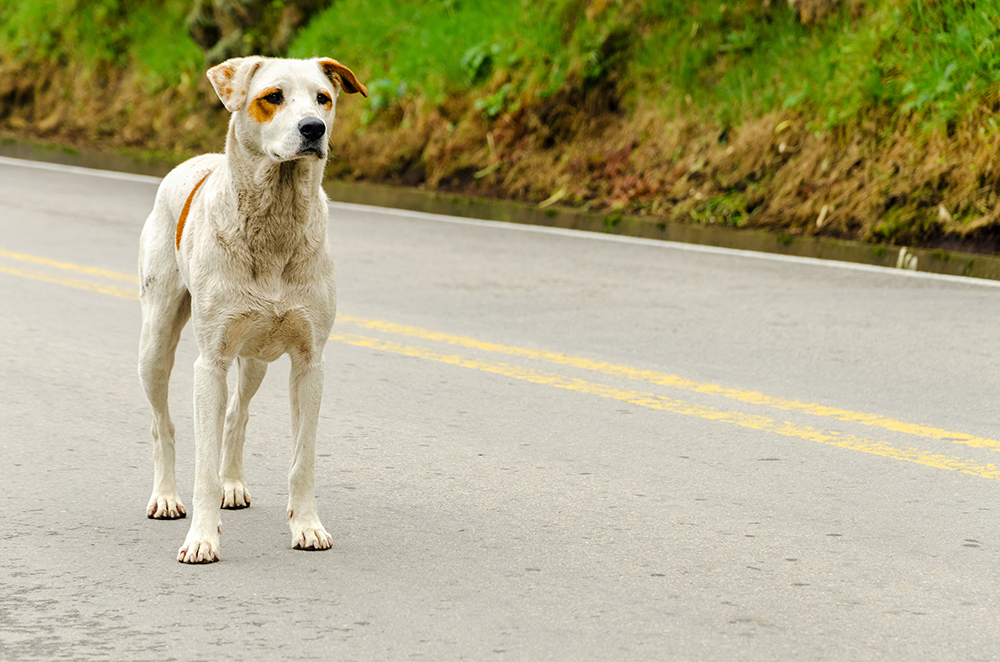 There are still a few places in the U.S. where stray dogs roam the streets. There are still a few places in the U.S. where stray dogs roam the streets.
|
There are still some places in the US where stray dogs run the streets. Some still inhabit poor, high-crime areas of major cities. Many are found in warm-weather states and US territories where strays are able to winter over.
In many cases rescue groups and/or animal shelters round up these dogs. In such cases, we have included these strays under our rescue or shelter category. Numerous studies, however, list strays as a primary source of pet dogs for a small percentage of families so we have listed that category here as well.
General considerations
A note of caution: We recommend that potential puppy buyers use common sense when purchasing a puppy from any source. For more detailed recommendations, read the NAIA Dog Purchasers’ Protection Act, model legislation to help consumers ask the right questions.
If you are adopting a dog from a shelter or rescue, carefully evaluate whether a particular dog is a good match for your family. If you adopt a dog solely out of compassion, you may create a hardship for your family.
If you are offered a dog from a friend, relative or neighbor, think carefully about whether it’s the right dog and the right time for you. If a breeder represents himself as being a devoted breed enthusiast but his dogs are ill-kept and poorly socialized, and the breeder has no records showing health testing, the buyer should question whether the breeder is truly what he represents himself to be. If a pet store says they buy only from good breeders, ask to see the USDA license numbers and inspection reports of their breeders. If you are buying a dog over the Internet, make sure the breeder is operating legally. USDA requires breeders with 5 or more breeding females to be licensed and inspected. The nasty kennels you see in the news are almost always operating illegally, evading current laws and regulations.
Labels like hobby breeder, commercial breeder, or casual breeder are helpful in providing a basic understanding of the attributes ascribed to each breeder group, but consumers need to assess for themselves whether the conduct of any individual breeder or pet store lives up to the advertised claims.
Likewise, negative labels should not be taken at face value. Anti-breeder groups, especially ones offering their own rescue or shelter dogs for adoption, often engage in broad-brush attacks on all breeders, but especially on commercial breeders, labeling them as puppy mills. Don’t accept any label at face value, good or bad, but do your own due diligence with the tools you find in this guide.
What to expect from a puppy: So you’ve decided to add a puppy to your family. You learned (or maybe already knew) about vaccinations and worming and housetraining and chewing and teaching the puppy not to nibble or nurse on fingers or nip the kids. You did the research, selected a breeder or other source, and brought your puppy home. Or you saw the cutest puppy in the pet shop … or your boss’s dog had a litter … or the rescue down the road just got a mother and pups from the shelter … or someone left a puppy on your doorstep …
Now what?
Regardless of your puppy’s origin, you face the prospect of teaching him to have good manners, an understanding of ground rules and where his honored place is in the family structure.
If you chose a private purebred breeder as a puppy source, you may be ahead of the game. Successful training begins with a breeder who teaches the puppy to sleep in a crate, hustles him outside after meals and naps to start housetraining, lets him drag a leash around the house or yard, encourages him to explore different surfaces and objects, and plays some games that lead to good manners. Some rescue and foster homes do these things, but pet stores, large scale commercial breeders, and shelters have not historically had the time or resources to invest in individual puppy development experiences. The importance of socializing your dog cannot be overstated, and the key to success is doing it on the puppy's timetable, not yours. If you wait until the time is right for you, you are likely to miss the crucial time for socialization in your puppy's development. The American Veterinary Society of Animal Behavior has developed a position statement on socialization that prospective and new puppy owners should read.
Housetraining: Housetraining is probably at the top of the frustration list. Most puppies cannot control their elimination reliably until they are at least four months of age, and some may take longer. In addition, puppies develop a substrate (surface) preference at a very early age and must learn to walk on grass, gravel, sand, dirt, concrete, and other outdoor surfaces. Good breeders understand this need; they take puppies outside regularly from four-to-five weeks of age and give treats and praise when the puppies eliminate. This practice gives puppies a head start and eases the housetraining process for buyers.
A schedule of outings is the first step in housetraining. Take the puppy outside to a relief spot whenever he wakes up, after meals, and the last thing before the family heads for bed. He can be loose in an exercise pen or small fenced area or on a leash. Be tough: absolutely no playtime until the job has been done. After he urinates or defecates, you should give him a tasty treat and lots of praise, then play.
Some hints:
You can see that several of these hints depend on the puppy’s breeder or early caretaker. For example, a crate is a good housetraining aid, but it’s a lot easier to use if the breeder accustomed the puppy to spending time in a crate. And if the breeder introduced the puppy to outdoor surfaces and started the praise and treat reward system for success, the puppy will likely learn quickly.
The puppy chewed my good shoes again! Chewing is undoubtedly number two on the puppy hit parade. Puppies chew because they are teething, because things taste good to them, and because they are bored or frantic. Many dogs never get over the urge to chew forbidden things but most at least slack off after getting their adult teeth.
Management is the first step in minimizing the loss of target items – management of the puppy and the family. The easiest way to protect treasured items is to limit the puppy’s freedom. If a family member can’t supervise him, put him in a crate or exercise pen and give him chew toys to gnaw on.
The next step is to teach family members to put away their valuables. They can close closets, put toys on shelves, and keep clothes out of reach. Human scents, particularly sweat and body oils, are especially attractive to puppies, so shoes, socks, and gloves are frequent favorites. Puppies also like the taste of soaps and toothpaste, glue (as in book bindings, envelopes, etc.), and the texture of wood, some plastics, and upholstery.
Don’t chase a thieving puppy; he’ll think you are playing and will respond by running away or jumping around to elude your reach. If a puppy grabs something he shouldn’t have, coax him to give it up by offering something more appealing that he can chew with impunity. Puppy biscuits, rawhide strips, a frozen carrot, a dampened and frozen fabric chew bone are all acceptable. Beware of hard plastic or natural bone chew objects; the former can cut puppy gums and the latter can splinter or actually crack new teeth.
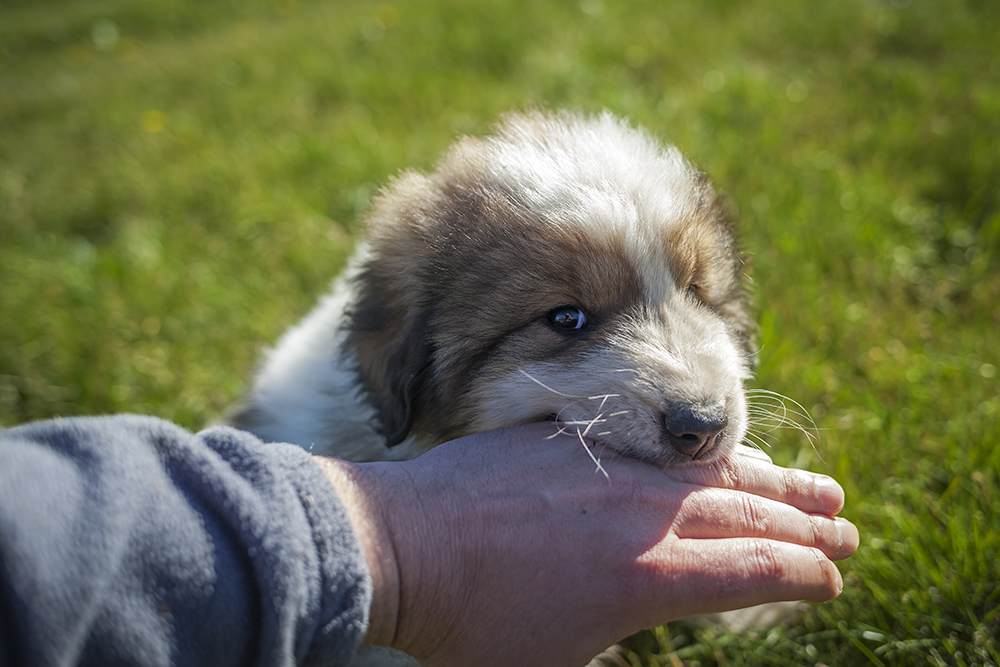 Nipping the kids can become a lifelong problem if not dealt with right away. Nipping the kids can become a lifelong problem if not dealt with right away.
|
The puppy’s nipping the kids!! Biting the kids is a close third on the frustration meter.
Puppies will grab just about anything to ease the discomfort of teething and will use their teeth to explore and control their environment. Housetraining is pretty much done when the puppy’s body matures to the point he can wait to go outside and chewing decreases when teething is over, but nipping the kids can become a lifelong problem if not dealt with right away. A puppy that nips can easily become a dog that bites, and a dog that bites can easily become a dog needing a new home.
There’s a lot of discussion about canine dominance behavior among dog trainers and animal behaviorists, but pet owners need techniques to prevent puppies from using their teeth to get their way, not hypotheses about pack hierarchy or alpha leadership. So, NAIA offers techniques and leaves the theories and philosophies for those who want to delve further into canine behavior and training.
Some puppies are well-mannered by nature and learn the house rules quickly. Others are brats, and it often takes extra patience to deal with them. But persistence and consistency pay off – and so does puppy kindergarten! Many dog obedience clubs offer classes for puppies that have completed their initial vaccination series, and these classes provide opportunities for owners to ask questions about puppy behavior and learn techniques for teaching good manners commands along with giving puppies a chance to socialize.
Now that puppy is trained and happy, how can I help him live to a ripe old age?
What is genetic testing and what does it prove? Just about every guide to selecting a purebred puppy recommends that buyers ask the breeder about genetic testing, and purebred dog clubs include testing for genetic defects in their breeders’ codes of ethics. Breeders make decisions about which dogs they will include in a breeding program based in part on the results of these tests.
There are two types of screening tests that breeders can use. One involves a blood sample or cheek cell swab to learn if the dog has the DNA (aka the genes) that causes or predisposes it to a particular disease. All body cells have DNA, making it easy to collect cells for examination. Scientists use cheek cell swab tests for several diseases, including types of heart and eye diseases and a bleeding disorder.
The other type of screening test checks the dog for signs of the disease or defect. Canine hip dysplasia, probably the most commonly known test given to purebred breeding dogs, involves x-rays of the hip joints. Other testing includes exams for autoimmune thyroid disease, eye diseases or abnormalities, hearing deficiency and some heart irregularities.
Breeders and canine health research: It is important to note that a partnership between canine health researchers and responsible breeders has identified and provided screening tests for several general and some breed-specific inherited conditions. Breeders and other owners provide research funds through individual and club donations and AKC grants to the Canine Health Foundation, and veterinarians, physicians, and other researchers do the laboratory work. Breeders also provide dogs for various studies through test breedings to help determine modes of inheritance, and they answer questionnaires about dog health and submit DNA samples to universities working on particular diseases, defects, or conditions.
Since the formation of the AKC Canine Health Foundation in 1995, canine health research has taken a giant leap forward because of the commitment of responsible breeders and their clubs. Spurred by the availability of grant money and the excitement of reaching medical breakthroughs, scientists have isolated genes implicated in some diseases; developed tests and protocols for finding some genetically-induced abnormalities in individual dogs; worked on treatments and cures for both genetic and non-genetic diseases, and studied various aspects of dog health and behavior. Their work covers cancer, structural defects, heart problems, autoimmune diseases, athletic abilities, hormonal imbalances, digestive ailments, skin diseases and more. Much of their research is also applicable to human medicine and has advanced the development of tests and cures for people afflicted with a variety of diseases and conditions.
So how do responsible breeders use this knowledge? They check their breeding stock for some genetic defects that affect a broad spectrum of dogs and for a few defects that may affect their specific breeds. For example, any dog, breed or mix, can develop canine hip dysplasia, a malformation of the hip joints that can cause pain and lead to degenerative arthritis as the dog ages, so serious breeders x-ray their dogs prior to the first breeding and submit the films to veterinary orthopedic specialists for examination. More details on hip dysplasia diagnosis are available at the Orthopedic Foundation for Animals and PennHip.
Other general tests include thyroid disease, eye defects, knee and elbow joint problems, and heart defects that may affect many breeds. Examples of breed-specific tests include copper toxicosis (a liver disease) in Bedlington Terriers; exercise-induced collapse in Labrador Retrievers; cystinuria (a urinary tract disease) in Newfoundlands; and MLS, a connective tissue disease that affects Beagles. Breed club health committees help identify the potential problems for their breed and make recommendations for specific tests.
Even though some diseases can be found with more frequency in a specific breed or a small group of breeds, they all have the potential to affect all canines – crossbreds and multi-breeds as well as purebreds. Criticisms that purebreds are less healthy than mongrels or cross-bred dogs ignores the fact that the same intensity of research has not been pursued for non-purebreds. It also ignores the fact that canines across the board are vulnerable to infirmity of one kind or another. Finally, in terms of the importance of research levelled at specific breeds and dogs in general, the findings and development of tests, treatments or cures for heart disease, structural abnormalities, circulatory diseases, autoimmune complexes, cancer, skin problems, etc., are useful for any dog diagnosed with one of these defects or diseases.
AKC’s commitment to canine health: AKC established the Canine Health Foundation (AKCCHF) with a $1 million endowment and contributed that same amount annually until the foundation established corporate partnerships and gained donations from other sources. By the end of 2015 AKC alone had donated $22 million to the AKCCHF while breed enthusiasts and their local kennel clubs donated millions more. Other major donors include Nestle Purina and the biopharmaceutical firm Zoetis. With this money and subsequent efforts, CHF has funded over $33.7 million in research projects and educational efforts, including over 790 grants.
So what do purebred critics spend on canine health research? Generally speaking, purebreds are not popular with animal rights organizations. Some actively work to eliminate purebred dogs and the breeding of purebred dogs. Such groups routinely denigrate purebred dogs as unhealthy, malign breeders as agents of ill-health, and run campaigns aimed at shaming buyers into taking a shelter dog instead of a well-bred puppy. At the same time, few - if any - of these groups put resources into supporting canine health research and education that would benefit all dogs, purebreds and mixes alike. They are happy to allege that AKC and breeders don’t do enough, but when it comes to public or financial support for the effort, they are silent. Long on criticism, absent when it comes to helping dogs. https://www.ucdavis.edu/news/purebred-dogs-not-always-higher-risk-genetic-disorders-study-finds Meantime, the AKC Canine Health Foundation puts millions into identifying genetic markers that enable breeders to eliminate canine diseases, whether found in purebreds or in mongrels.
Pros and cons of canine sterilization surgery: Nothing’s perfect; there’s no free lunch, no pro without a con, no medicine without side effects, no decision without unintended consequences, yet most animal welfare proponents and virtually all animal activist groups insist that sterilization surgery is not only essential for dog health and well-being, it is part and parcel of responsible pet ownership and a preventive measure for “pet overpopulation.” In fact, those who question this “wisdom” are often accused of promoting the deaths of shelter dogs.
But knowledge is power: learning about the cons as well as the pros of sterilization allows owners to make informed decisions instead of bowing to the overwhelming social pressure to sterilize as soon as possible.
Obviously, sterilization surgery, spay for females, neuter or castration for males, removes the dog’s ability to produce puppies, a huge advantage for the vast majority of pet owners. Added bonuses include the elimination of heat seasons for females (and the corresponding need for management during the season), perhaps a decrease in marking (urinating on spots to mark territory), mounting, and wandering behavior for males, and a reduction in the potential for some cancers in both sexes.
However, facts also show that, while spay/neuter campaigns have been instrumental in reducing indiscriminate puppy production, the decision to sterilize (or not sterilize) a pet can have medical and behavioral consequences for dogs and practical and political implications for owners. New research, new laws and regulations, management and financial ability, and the potential for responsibly producing and placing healthy puppies should weigh into the decision.
New medical research: Sterilization is definitely a practical solution for owners who don’t want to deal with the potential for puppies, but new research shows that there are medical and physical downsides to the surgery, especially if it is done before the dog is physically mature.
Complete spay surgery, an ovariohysterectomy, removes the female ovaries and uterus and cuts off the major source of estrogen, a hormone that is critical for proper growth as well as reproductive system development and maintenance. However, the surgery not only ends reproductive capacity and reduces the potential for mammary gland cancers and uterine infections; it also may increase the potential for other cancers, for abnormal growth of long bones that can lead to knee and hip joint complications, and for thyroid disease, obesity, urinary incontinence, urinary tract infections and, not the least important, longevity itself. A revolutionary study published in 2009 demonstrated that spaying a bitch before the age of negatively impacts longevity.
Neuter surgery removes the testes from male dogs, reducing the production of testosterone and perhaps providing some protection from prostate disease. Potential detrimental effects of neutering include obesity, increased potential for thyroid disease and prostate cancer, and knee and hip joint injuries or malformations. Some breeds are prone to conditions such as hip dysplasia, hypothyroidism, and some cancers, so owners of these breeds or their mixes should have this information. Dogs sterilized before reaching physical maturity seem to be at higher risk of many adverse conditions. For example, reproductive hormones play a part in bone development and growth rate, so dogs spayed or neutered before growth plates close tend to have longer, lighter bones and different joint angles than intact dogs of their breeds. This deviation can make an active dog more prone to joint injury. Osteosarcoma and hemangiosarcoma, two particularly aggressive types of cancer, are also more common in spayed or neutered dogs.
The risks are small but potentially significant in breeds that are predisposed to particular diseases or conditions. For example, German Shepherds, Golden Retrievers, Labrador Retrievers, Boxers, Doberman Pinschers, and English Setters seem to have a predilection for deadly hemangiosarcomas, so owners benefit from learning that the incidence of this cancer is higher in spayed females than in intact females. Rottweilers and Great Danes are highly susceptible to osteosarcoma, an aggressive bone cancer that appears to be more common in spayed or neutered dogs. Cruciate ligament (knee) injuries occur more often in large athletic breeds, and some breeds have a tendency to gain weight, especially after sterilization surgery, so owners of these dogs might want to assess these factors when making a decision to spay or not. Please see Does Early Castration Increase the Risk of Cancer in Dogs?
Behavior and neutering
Spay and neuter surgeries often help prevent or modify sex-linked behaviors. Many castrated dogs have fewer tendencies to roam or mark territory with urine and are less likely to get into fights, but these benefits are far from universal. Spayed females do not exhibit hormone-induced personality changes during breeding seasons or have false pregnancies that cause them to nest and guard toys and food.
However, some studies indicate that sterilized dogs can be more aggressive, fearful, excitable, and less trainable than intact dogs. The biggest differences occurred when the dogs were sterilized when less than a year of age.
Social pressure to sterilize: Massive campaigns to spay and neuter pets have successfully reduced the number of unwanted litters and subsequently decreased the number of shelter deaths. Thirty years ago, shelters euthanized an estimated 20 million dogs annually; today that number has dwindled to 1.2 million. Shelters now euthanize few puppies, proving the success of the campaign. Many areas of the country actually have a puppy shortage, but rather than recognize their success and send prospective adopters to responsible breeders, many US shelters import puppies from states that still have a surplus and from the streets and rural areas of foreign countries.
It took a couple of decades to convince pet owners to sterilize using health and management arguments. Once the ball was rolling, spay/neuter advocates pushed these arguments to the back burner in favor of “spay and neuter your pet to combat overpopulation” and encouraged people to “adopt, not shop” when looking for a pet. No one thought about the downsides; unfortunately, today sterilization is included in many definitions of responsible pet ownership and those who keep dogs intact have become characterized as pariahs by many spay/neuter activists.
Government pressure to sterilize: Social pressure to sterilize has morphed into government pressure as officials succumb to activist campaigns and pass laws and regulations that raise the costs of keeping intact dogs. Many jurisdictions charge a premium license fee to own an intact dog and some tack on an extra fee to produce a litter. Shelters often charge higher reclaim fees for lost intact dogs than for stray sterilized dogs.
California has some of the highest differential license fees in the US. License fees for intact dogs in Los Angeles County communities range from $20-$75 per year with most areas charging $60. In most cases, this fee is double or triple the cost for a sterilized dog. The City of Los Angeles has the highest fees: $100 to keep an intact dog and an additional $235 to breed that dog. There is zero evidence to indicate that these fees have caused any improvements several years after their adoption. Other regulations favor sterilized dogs over intact dogs. Some jurisdictions require the surgery for intact dogs that are animal control problems and some require the surgery for dogs that they consider dangerous by breed.
Responsibility for keeping an intact dog: There’s no doubt that housing an intact dog can be challenging. Females are “in season” for about three weeks at an average of every six to eight months. The season involves a vaginal discharge that can stain carpets and furniture, and although she is fertile only for a few days during that time, she can attract males for a while before and after as well as during the breedable period, making secure confinement necessary. She may also experience changes in personality, becoming more affectionate or moody or even snappish.
Male dogs are hard-wired to breed if they find a female in season. Contrary to some opinions, the fact that a male dog is intact does not make him more aggressive than neutered dogs, but it does make him single-minded when he sniffs out a female in season. Male dogs also tend to mark their territory with urine, a behavior that can ruin furniture and walls and kill shrubs and other plants.
So, some hints:
References
Exploring mechanisms of sex differences in longevity: lifetime ovary exposure and exceptional longevity in dogs, David J. Waters, DVM, Ph.D., Purdue University,
Evaluation of the risk and age of onset of cancer and behavioral disorders in gonadectomized Vizslas, M. Christine Zink, DVM, PhD; Parvene Farhoody, MA; Samra E. Elser, BS; Lynda D. Ruffini; Tom A. Gibbons, MS; Randall H. Rieger, PhD, Abstract in AVMA Journal, February 1, 2014;
Determining the best age at which to spay or neuter: An evidence-based analysis by Margaret Root-Kustritz, DVM, Ph.D., University of Minnesota; Discoveries, Spring 2008;
Long-Term Health Risks and Benefits Associated with Spay/Neuter in Dogs, Laura J. Sanborn, MS, May 14, 2007,
Early Spay-Neuter Considerations for the Canine Athlete: One Veterinarian’s Opinion, © 2005 Chris Zink DVM, Ph.D., DACVP, DACVSMR; Extensively revised and updated – 2013;
Behavioral and Physical Effects of Spaying and Neutering Domestic Dogs (Canis familiaris) Summary of findings detailed in a masters thesis submitted to and accepted by Hunter College by Parveen Farhoody in May, 2010
The Society for Theriogenology: Position on Mandatory Spay-Neuter in the Canine and Feline
County of Los Angeles Department of Animal Care and Control license fee schedule
City of Los Angeles animal breeder permit information
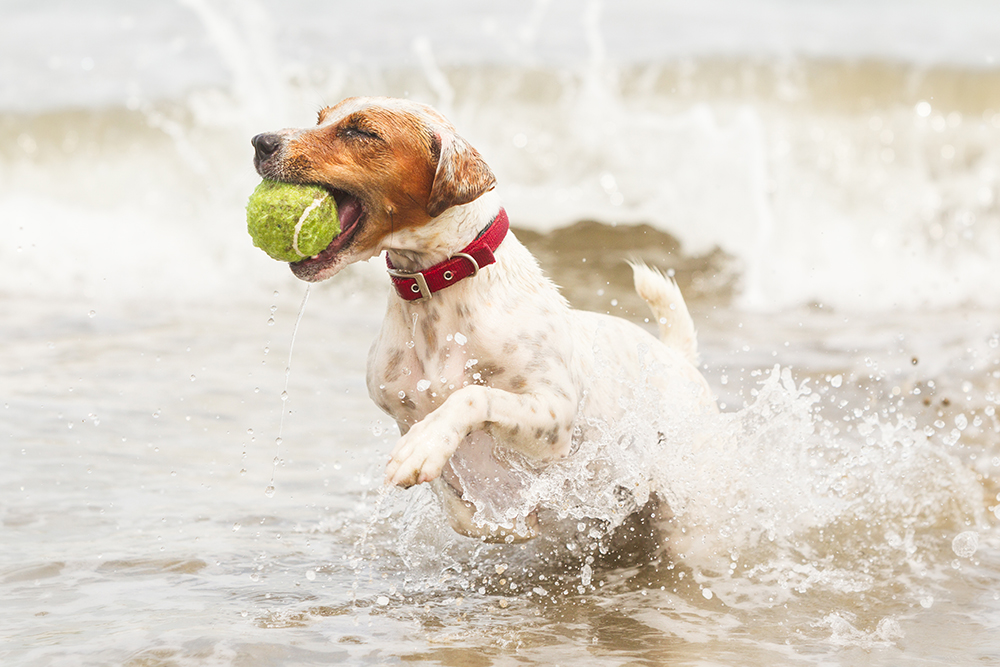 If you are looking for fun activities that you and your dog will both enjoy, the list is as long as your imagination! If you are looking for fun activities that you and your dog will both enjoy, the list is as long as your imagination!
|
Sit, stay, down, and beyond: There’s no doubt that people and dogs have an intricate history. Herding dogs, hunting dogs, hounds, terriers, draft dogs, guard dogs, even toy dogs all contributed to the development of civilization. But even though farmers, hunters, gamekeepers, shopkeepers, and kings and queens had favorite dogs, the animals were definitely not pets as we perceive them today. The dogs knew their jobs, and their owners bragged about their value in the pastures, fields, royal forests, and granaries but generally did not welcome them into their homes.
Things have come 180 degrees today. Few dogs have jobs and a large and growing number of dog owners consider their dogs as members of their families. Of all the non-human animals that share our lives, dogs seem to harmonize best.
Our relationship with dogs in general and a dog in particular doesn’t just happen, at least in most cases. Since dogs are dogs and not furry humans, they have their own perspective on the world and their own innate behaviors. Owners can take one of several tacks when bringing a dog into their home: give Fido complete freedom to be a dog; cast him into the role of furry child; try to dominate the poor pup; or find a middle ground that allows the Fido to be a dog while indulging some of his whims and guiding him to more acceptable behaviors when necessary.
Good manners training and management as outlined in “What to Expect from a Puppy” and “Rescue Expectations” are essential for all dogs. The old saw that “you can’t teach an old dog new tricks” has been superseded by the knowledge that most dogs regardless of age can be taught or managed so that their behaviors are at least acceptable in the home and at best are exemplary.
Many people who open their homes and hearts to a dog find such joy in successfully teaching manners and tricks to their pets that they want to do more. Well, the door is wide open.
The American Kennel Club offers dozens of opportunities to train and compete in sports that mimic a breed’s natural job, as well as activities that harness their innate abilities to learn a variety of tasks and movements.
Therapy Dogs International and other groups test and certify dogs to visit nursing homes, hospitals, libraries, homeless shelters, etc. to provide emotional support for patients, listen to children read, and bring some joy to society’s downtrodden.
Search and rescue organizations help train dogs for vital work at natural disasters and other incidents that call for the keen senses of a canine partner. Many search dogs are family pets first and foremost.
There are even organizations that promote canine freestyle dancing for graceful owners and agile dogs.
The American Kennel Club is the world’s premier source of options to have fun with your dog and build a working partnership with a well-socialized canine companion. Want to find out if your sporting dog maintains his hunting instincts? Try an AKC hunt test. Think your herding dog can gather a flock? Try an AKC herding instinct test. Want to know how good your dog’s nose is? Train him for an AKC tracking test.
Are you enthusiastic about agility competition or pleased by teaching your dog a series of exercises that challenge your training ability and make use of his hidden talents? Try AKC obedience, Rally, or agility training.
Thinking about breeding your dog? Have her evaluated by judges at an all-breed conformation show.
AKC has an extensive network of clubs that host annual events such as conformation shows to assess breeding quality, companion events that test obedience and tracking skills and agility; and tests and trials geared to dog breeds developed to hunt game birds, find rabbits and raccoons, chase down swift game animals, and herd sheep. Individual AKC clubs may also have their own breed-specific tests. For example, the Newfoundland Club of America has both carting and water rescue tests; the Dalmatian Club of America recognizes owners and Dalmatians who complete more than 100 miles per year in endurance activities; and the Samoyed Club of America offers titles in sledding, weight pull, and skijoring.
AKC has hundreds of clubs to help you get started. Breed parent clubs offer breed information and conduct specialty events to showcase their breeds. All-breed kennel clubs conduct shows and serve the breeders, exhibitors, and pet owners in particular areas. Training clubs offer good manners and competition classes for the public and host obedience, agility, Rally, and tracking tests and trials. Field event clubs offer tests and trials for hunting, herding, and coursing dogs.
Although AKC’s primary purpose is to promote and protect purebred dogs, crossbred and mixed breed dogs can also participate in obedience, Rally, agility, and tracking events. To find a local AKC clubs go here.
Therapy dogs
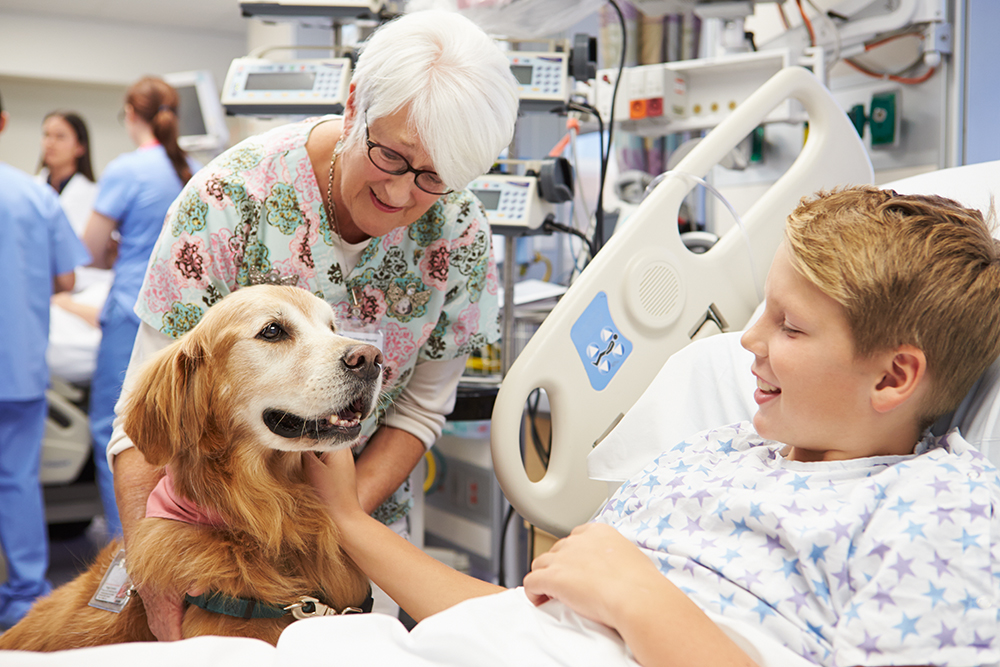 A dog's natural empathy makes them especially well-suited in the role of therapy animal. A dog's natural empathy makes them especially well-suited in the role of therapy animal.
|
Dogs have a natural empathy with people, a connection that makes them invaluable to patients and others in need. The prerequisites for a therapy dog include good manners obedience training, an affinity for people, and a stable temperament. They must be free of parasites, healthy, and not easily startled by quick movements or loud noises.
Therapy dogs fill a range of needs from providing a non-judgmental listener to children learning to read to visiting hospitals, group homes, adult care facilities and helping victims overcome traumas such as the Newtown (Connecticut) school shooting in 2012 and disasters such as the Oklahoma tornadoes. Therapy Dogs International features videos of therapy dogs at work on its website at http://tdi-dog.org/ .
Some hospitals and nursing homes have their own therapy dog training programs but most rely on a local or national training group to teach dogs and owners the necessary behaviors. Dogs must be steady on floors that can be slick, cope with the clattering of bedpans and the smells of disinfectant and illness, and deal with the quick movements and even hugs of children and the elderly if they visit these institutions. They also must be clean, free of parasites, and not actively shedding.
Many training clubs have members who regularly schedule therapy visits to a facility in their communities. AKC recognizes a therapy dog each year during its ACE Awards presentation at the Eukanuba Invitational Dog Show and offers a title in therapy work for dogs that log at least 50 hours of visits, have an AKC registration number, and are certified for therapy work by one of the organizations listed here. http://www.akc.org/akctherapydog/organizations.cfm . Purebred dogs of unknown origin and mixed breed dogs are eligible if they are enrolled in the AKC PAL program or listed in the Canine Partners Program.
Service dogs: Service dogs are trained to perform a specific job for an owner who faces physical or emotional hardships. Service dogs are also known as assistance dogs. Therapy dogs are generally pets or show dogs that are invited into schools, hospitals, and other institutions to visit with students and patients. Service dogs are working dogs that provide mobility and emotional support for their owners and help them function in public.
Years ago, most service dogs were guide dogs for vision-impaired owners. Then came wheelchair assistance dogs and dogs trained to alert deaf owners to doorbells, telephones, and other sounds. Now service dogs aid veterans suffering from debilitating injuries and post-traumatic stress disorders, children with autism, and others with psychological or emotional illnesses and serve as support for owners with progressive diseases such as muscular dystrophy.
Organizations such as Canine Companions for Independence raise and train dogs to perform specific, often complex, tasks. However, there are many smaller groups that train family pets as medical alert dogs for diabetics and epileptics, autism support dogs for children, and other purposes, such as signaling when your blood sugar is out of whack or when a seizure is imminent.
The federal Americans with Disabilities Act defines dogs as service animals and grants them access to businesses and other places open to the public. The regulations prohibit business staff members from asking specific questions about the handler’s disability but can ask if the handler requires the dog because of a disability and what tasks the dog is trained to perform.
For more information about service dogs, see Canine Companions for Independence, Pilot Dogs, and Dogs for the Deaf.
AKC’s ACE (Awards for Canine Excellence), a project of the AKC Humane Fund, recognizes a service dog in a ceremony at the Eukanuba Invitational Dog Show each year.
For the last 4 decades commencing in the 1980's, states, cities, counties, and other jurisdictions began to enact a broad spectrum of laws and regulations restricting dog ownership. The result: In a nation of dog lovers, a growing body of laws and regulations limit or prohibit ownership of certain breeds or types of dogs; tax the ownership of intact dogs and dog breeding; set standards for dog care in kennels; dictate who can sell or adopt dogs to the public; specify the type of fence (or prohibit fencing altogether) a property owner can have; ban or limit the use of tethers; and bar various husbandry practices such as tail docking, ear cropping, and bark softening.
So, these days, ignorance definitely isn’t bliss; what you don’t know about dog laws, policies, and regulations can disrupt your world unless you arm yourself with knowledge.
 Ignorance is not bliss: what you don’t know about dog laws, policies, and regulations can really disrupt your world! Ignorance is not bliss: what you don’t know about dog laws, policies, and regulations can really disrupt your world!
|
These laws generally fall into four categories:
1. Zoning ordinances: Most US jurisdictions have a set of zoning regulations that divide properties into categories and limit property use to protect the land and the neighborhood. A zoning code may also limit the number of dogs in a household, standardize the type of fencing allowed, prohibit puppy sales, and dictate the location of outdoor dog pens, exercise runs, dog houses, or kennel buildings. Violations of zoning laws are generally considered administrative offenses and can result in a loss of dogs and/or a fine.
2. Health and safety ordinances: This broad category encompasses traditional animal control laws that provide for dog warden services to capture, house, return or dispose of at-large or problem dogs, dog bite policies, and rabies vaccination programs. Impoundment of strays, procedures for dealing with aggressive or nuisance dogs, government shelter adoption policies, bans on specific breeds or types of dogs, and nuisance ordinances for barking dogs fall into this category. Some jurisdictions also place dog number limits in their health and safety rules instead of zoning ordinances. Violation of health and safety ordinances can be administrative or criminal offenses; if they are included in criminal code, they can result in imprisonment.
3. Crisis or single-issue ordinances and policies: Local humane societies or rescue groups often promote these laws and rules out of concern for dogs, but a local dog bite or nuisance incident or the discovery of a substandard breeding kennel may be the driving force. For example, a shelter or rescue group may piggyback on a national group’s demand for restrictions on dog breeding or a local citizens’ group may take up the cause for a breed ban out of fear of attack by a certain type of dog. If the campaigns are successful, the resulting ordinances may fall into either the zoning or health and safety categories or fit into the community’s general administrative or criminal laws about animals.
4. Conflict fundraising laws: National fundraising groups such as HSUS and PETA drive full-blown campaigns to pass laws that restrict dog breeding, ban some husbandry practices, or place burdensome one-size-fits-all standards on kennel owners. They seize on a problem or create an issue, then conduct an all-out assault using sophisticated advertising efforts, media manipulation, and public pressure to bully legislators and policymakers. The end result of a successful conflict fundraising campaign is that consumers have fewer choices for purchasing a well-bred puppy and fewer choices after they bring the puppy home. You can recognize a conflict fundraising crusade by the pleas for cash, defamation of opponents, rousing rhetoric that obscures reasonable solutions to a stated issue, and an often illusory relationship with the facts.
Pet owners may also face constraints imposed on residential developments directed by an association of property owners. These constraints are often included in the policy manuals given to new residents and can include limits on the size or weight of the dog, guidelines for fences, curbs on dog houses or exercise pens, and breed bans. They are not laws but matters of contracts between residents and the managing homeowners association board.
These are the shoals and reefs that await dog owners throughout the country. It’s no longer enough to take good care of pets and kennel dogs, it is necessary to beware of lawmakers, do-gooders, and radical activists who insist that their way is the only correct way to do the job. So some navigation hints from NAIA:
 Discover Animals is a web-based educational resource offered by the NAIA
Discover Animals is a web-based educational resource offered by the NAIA